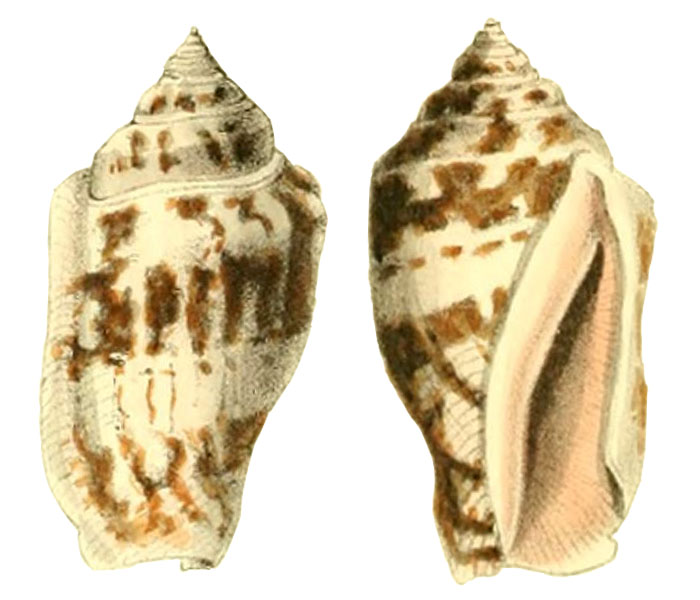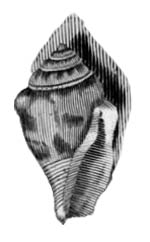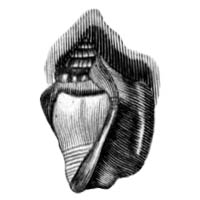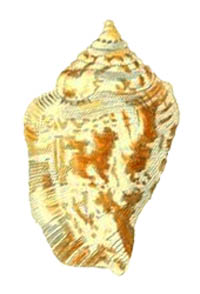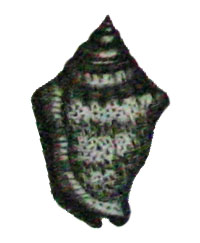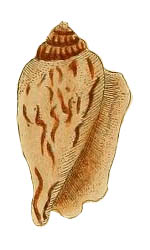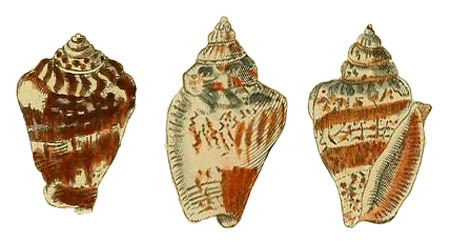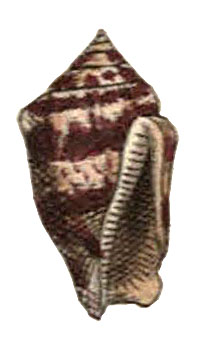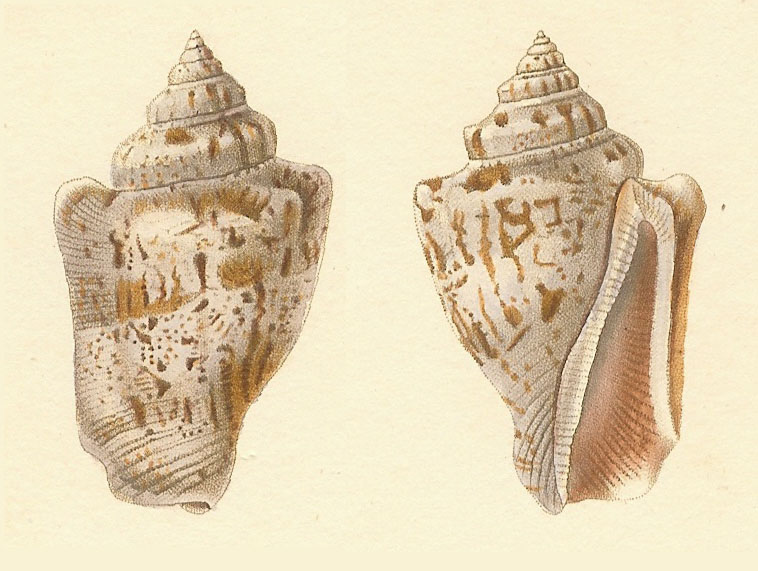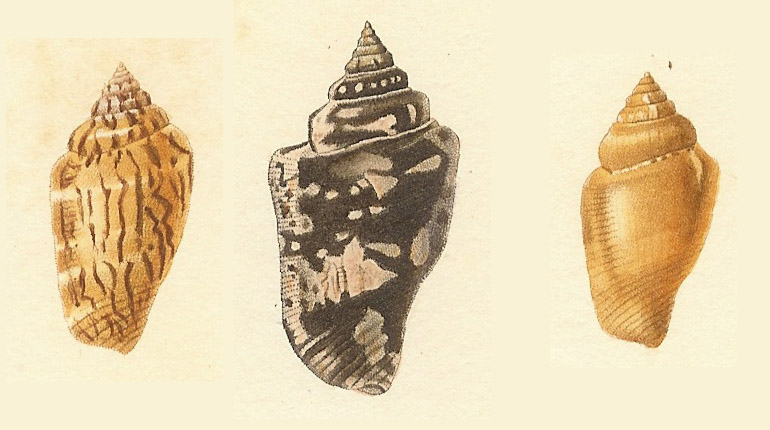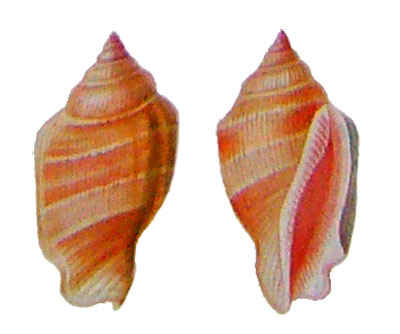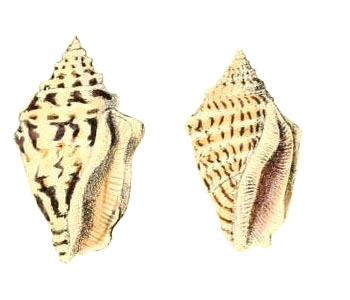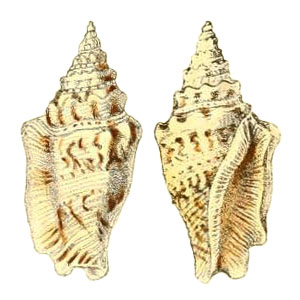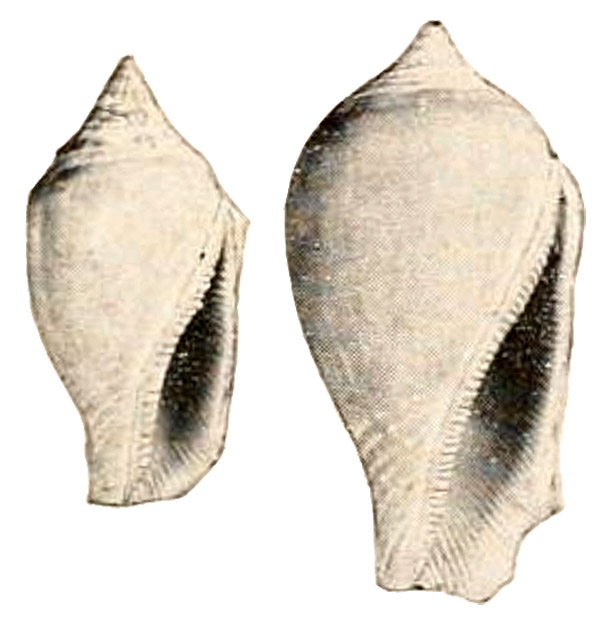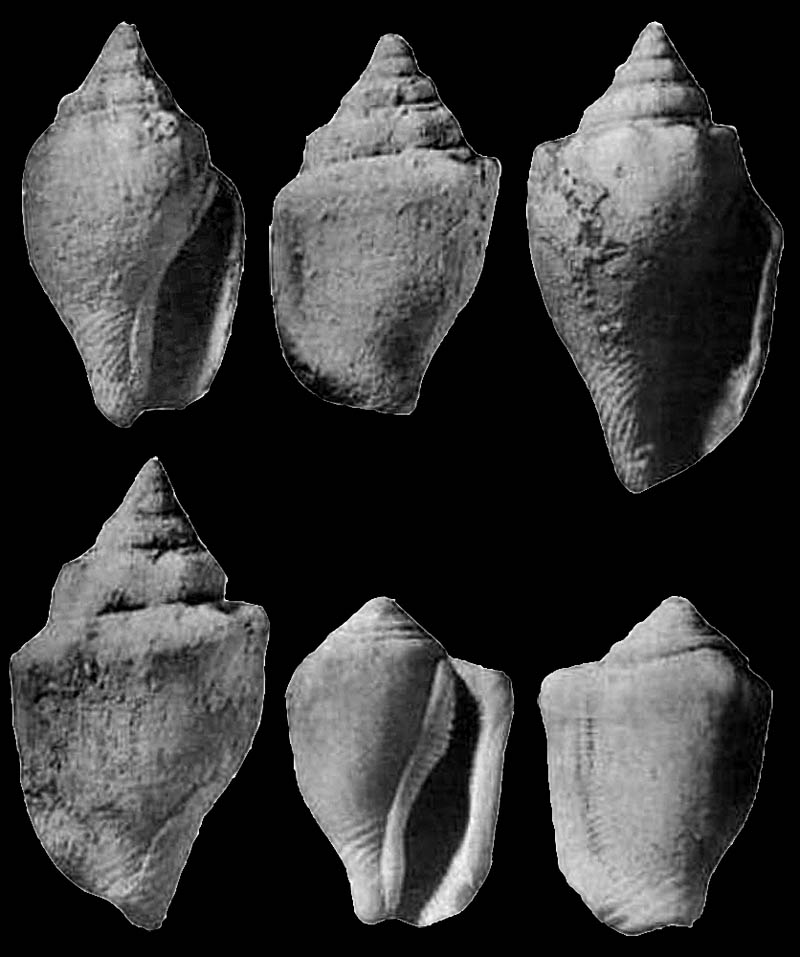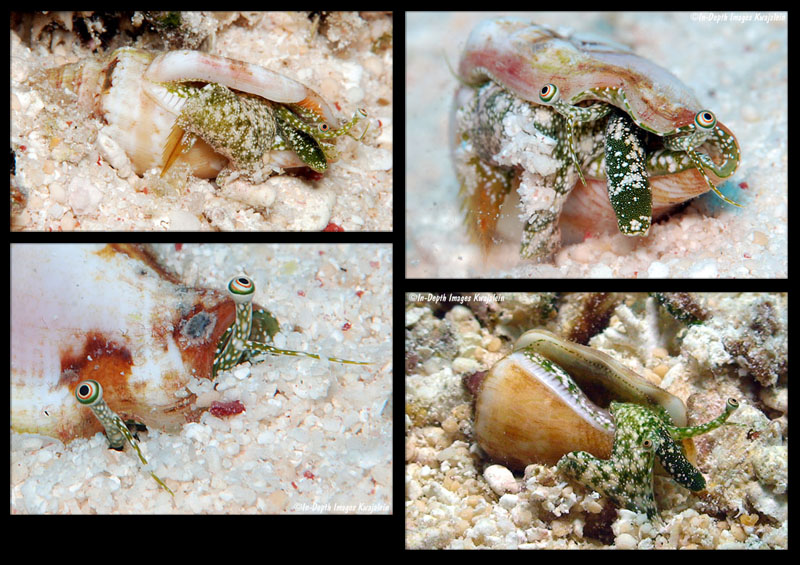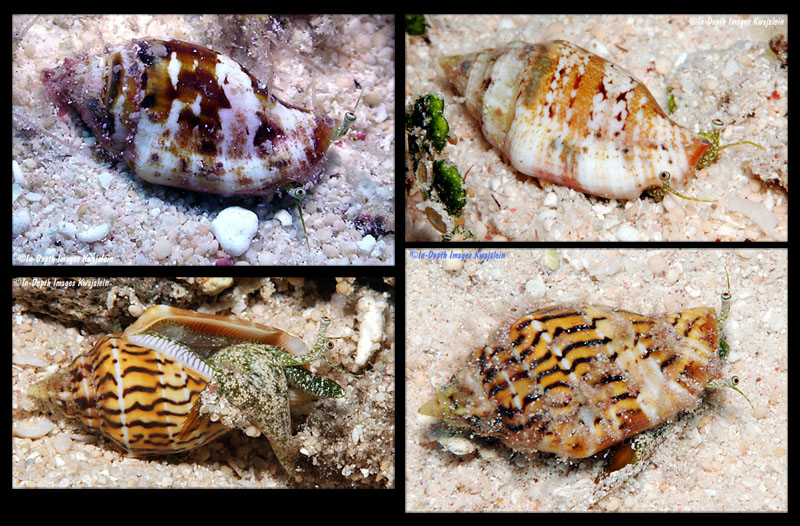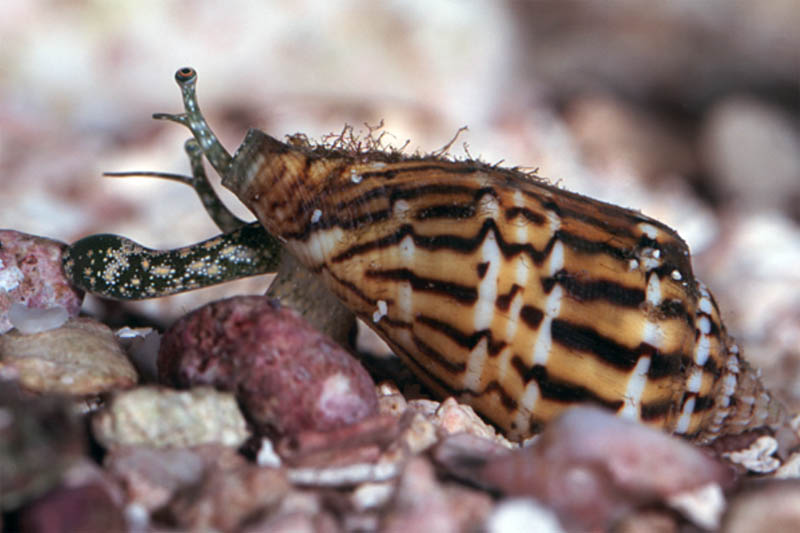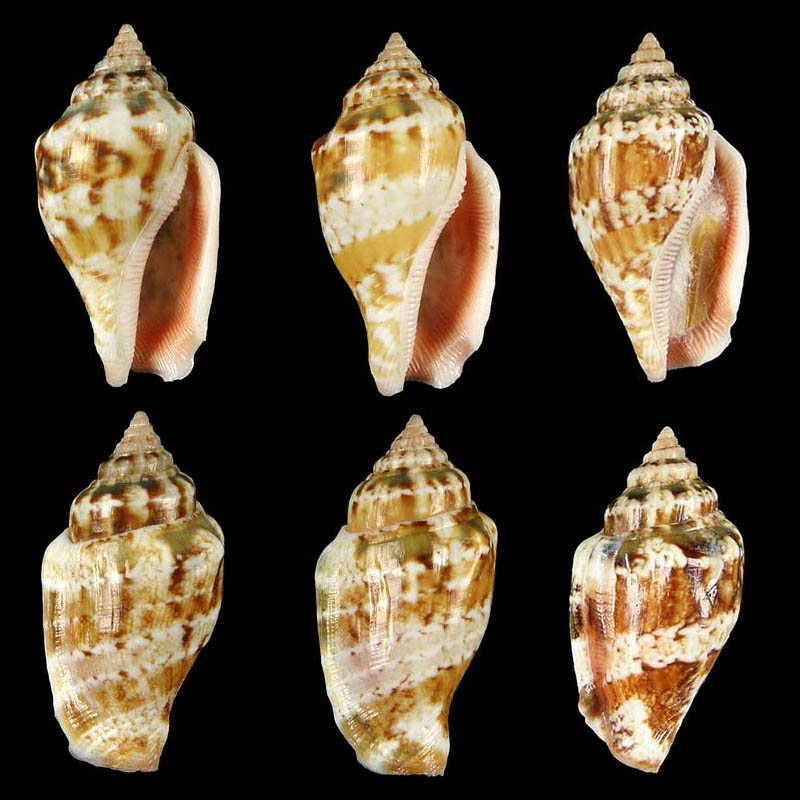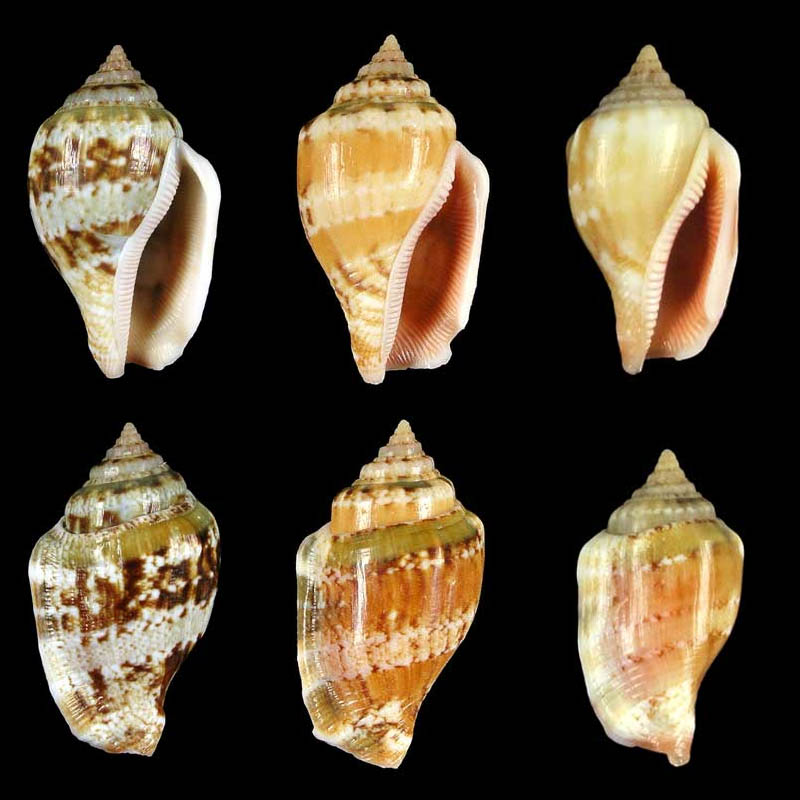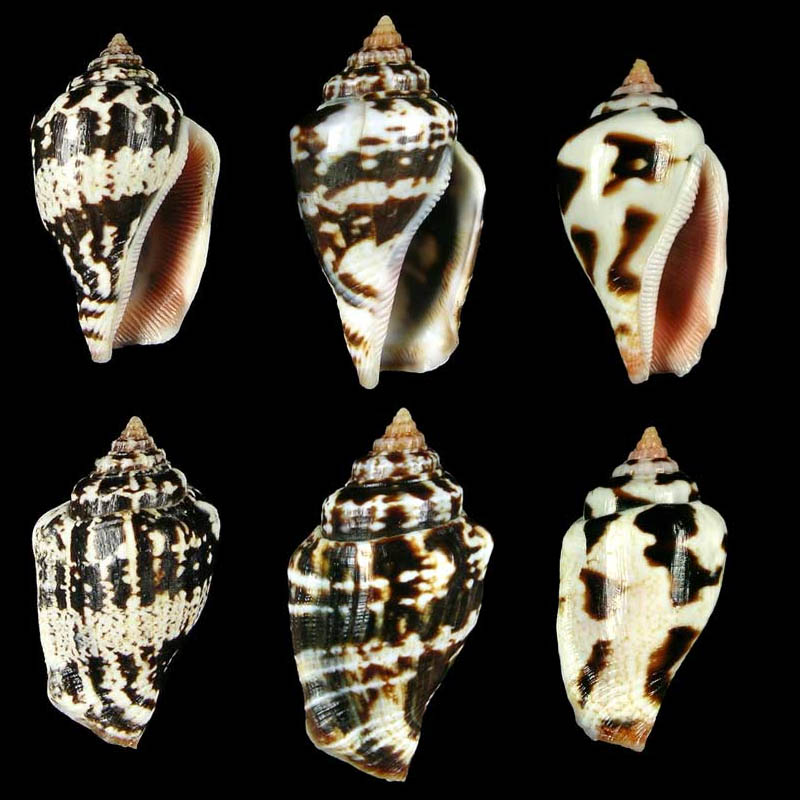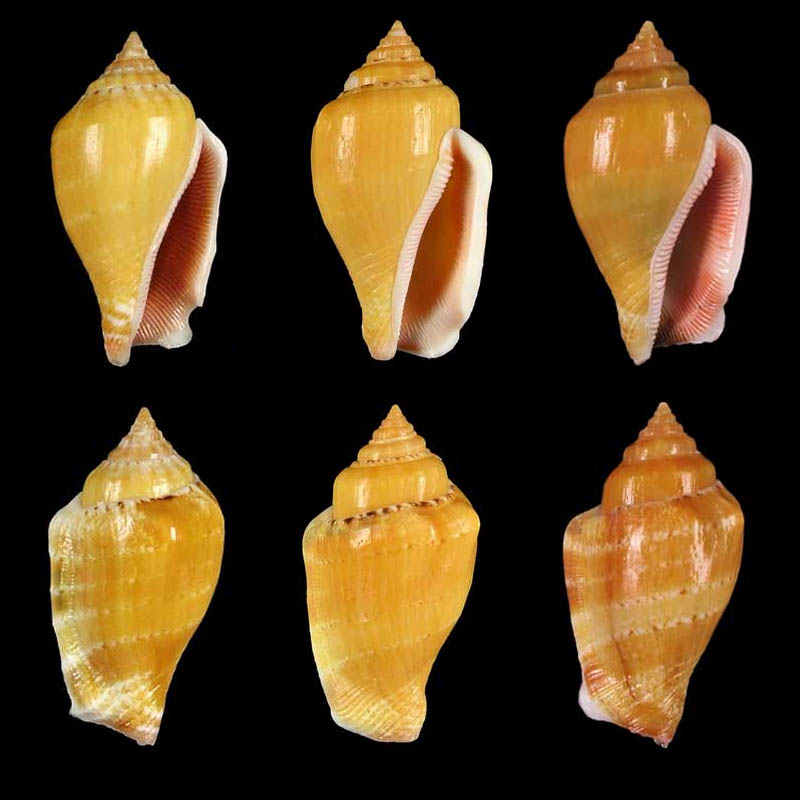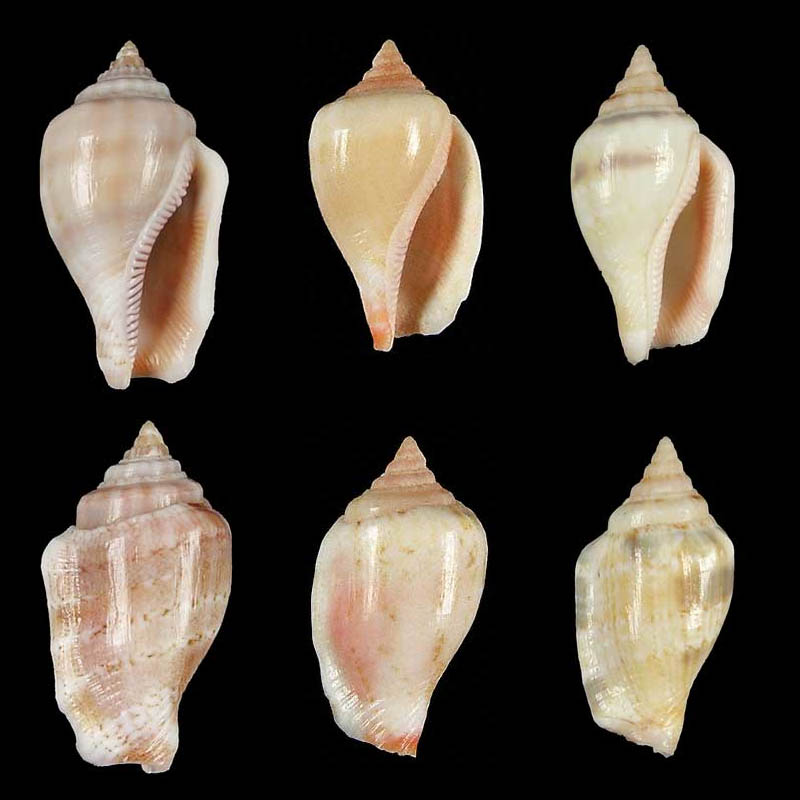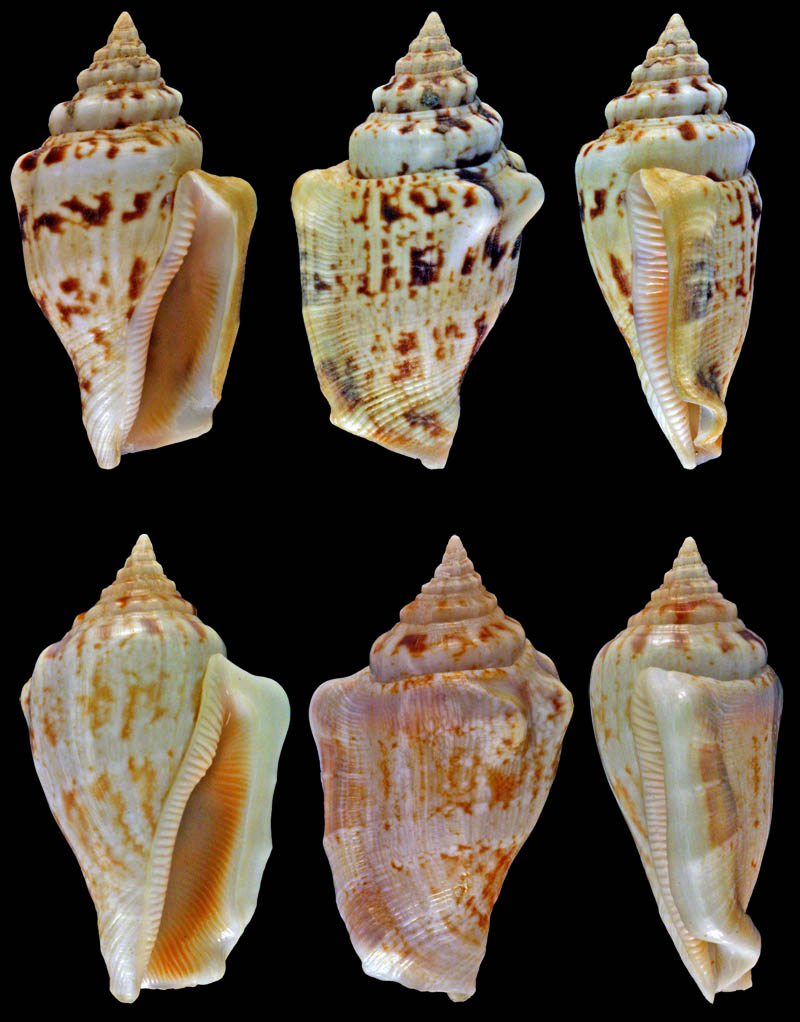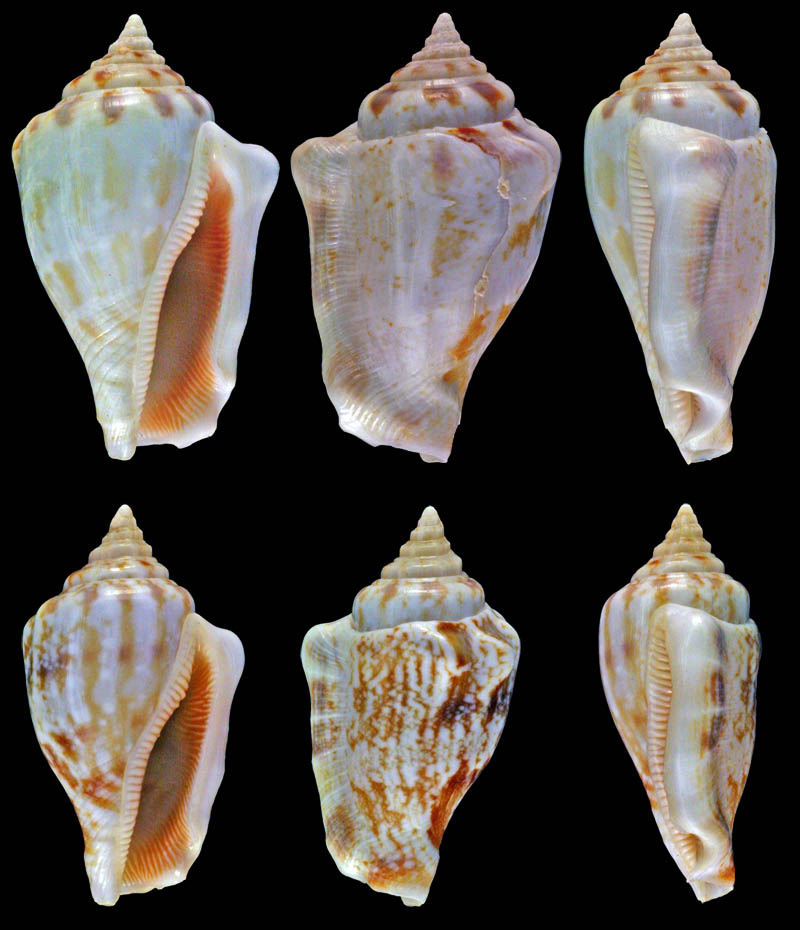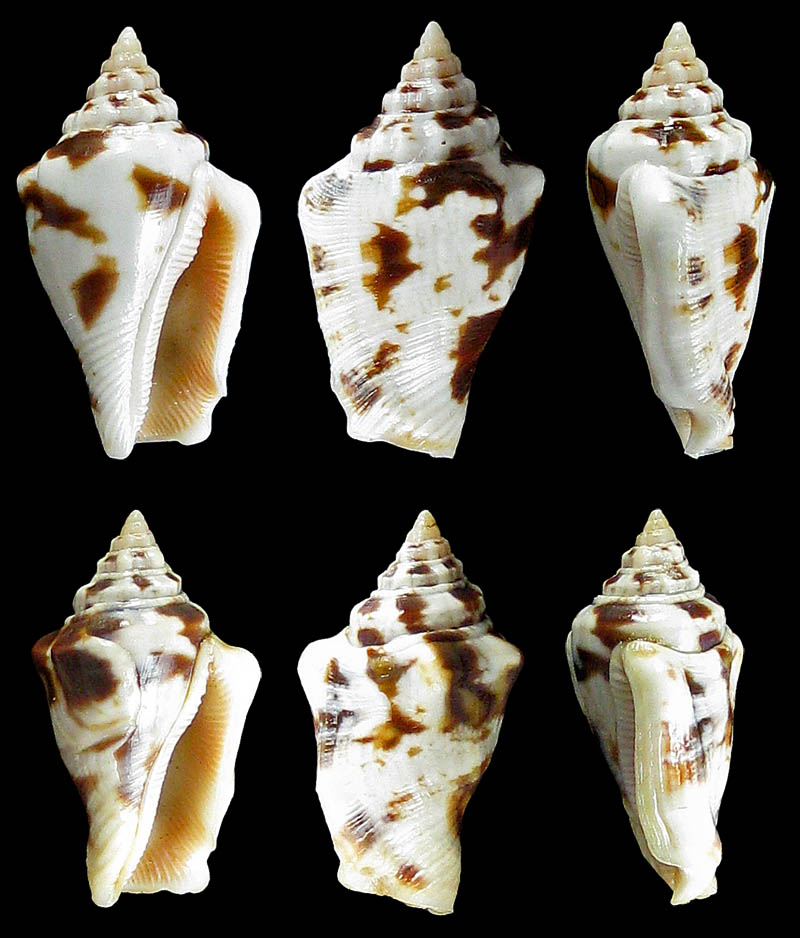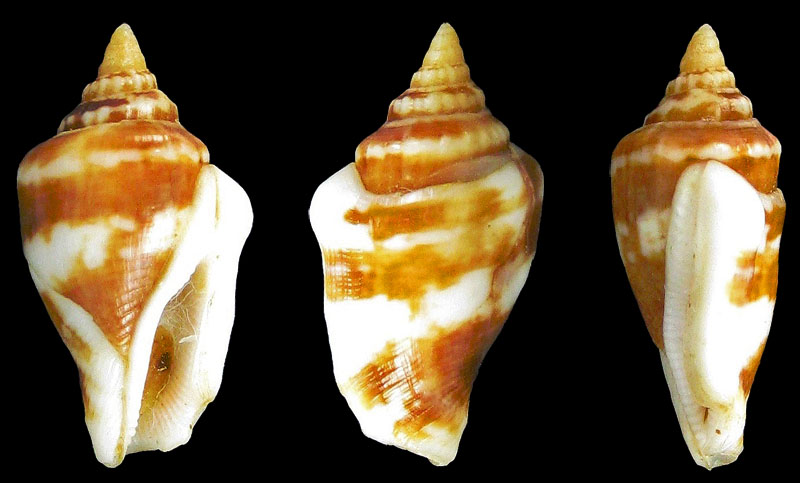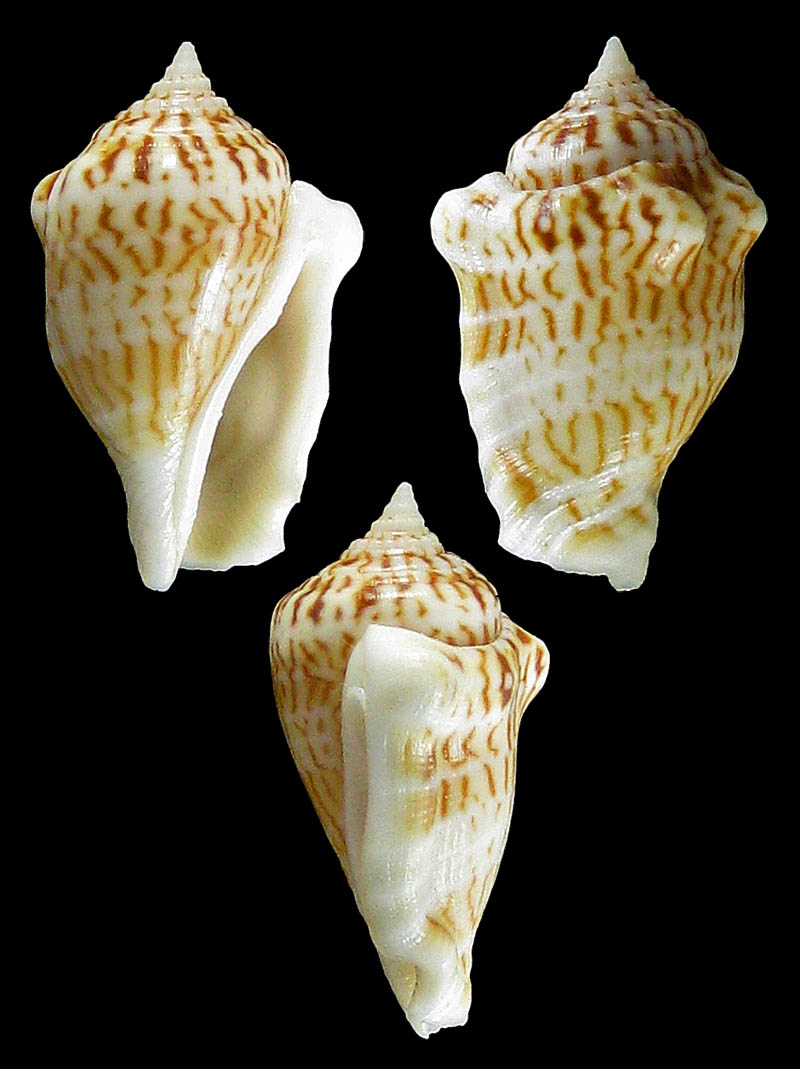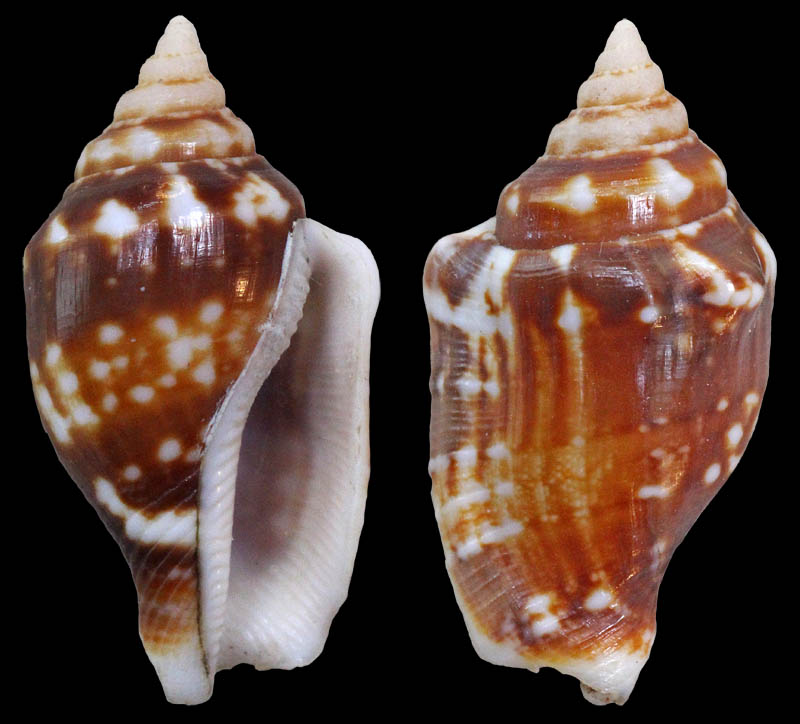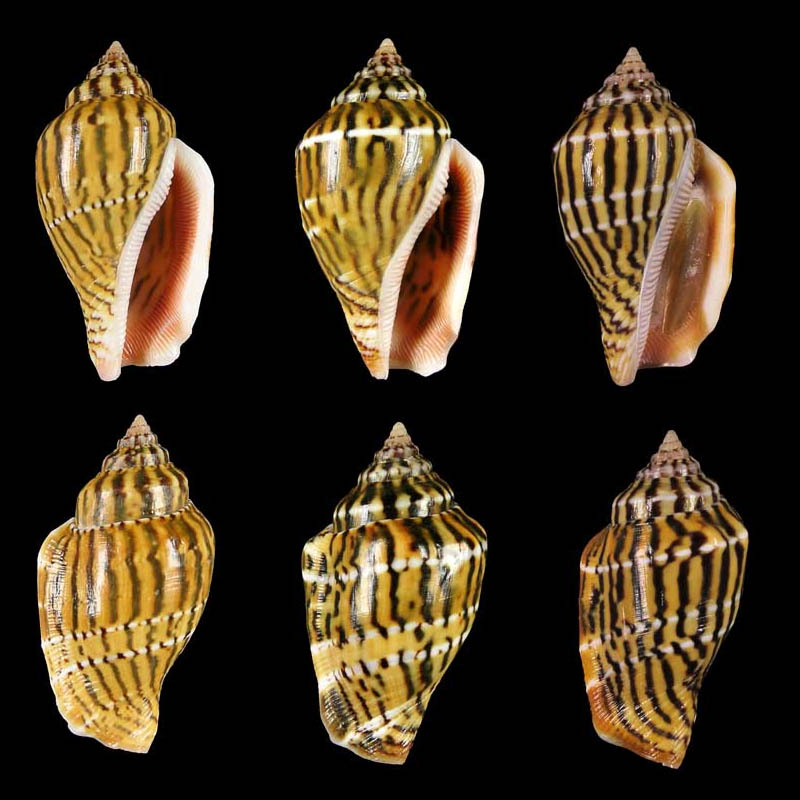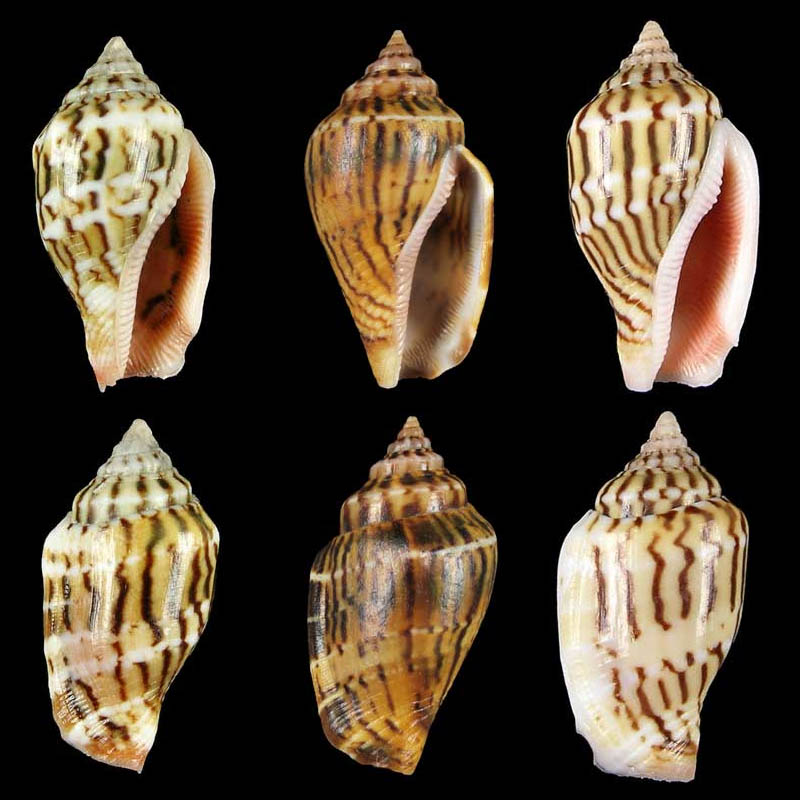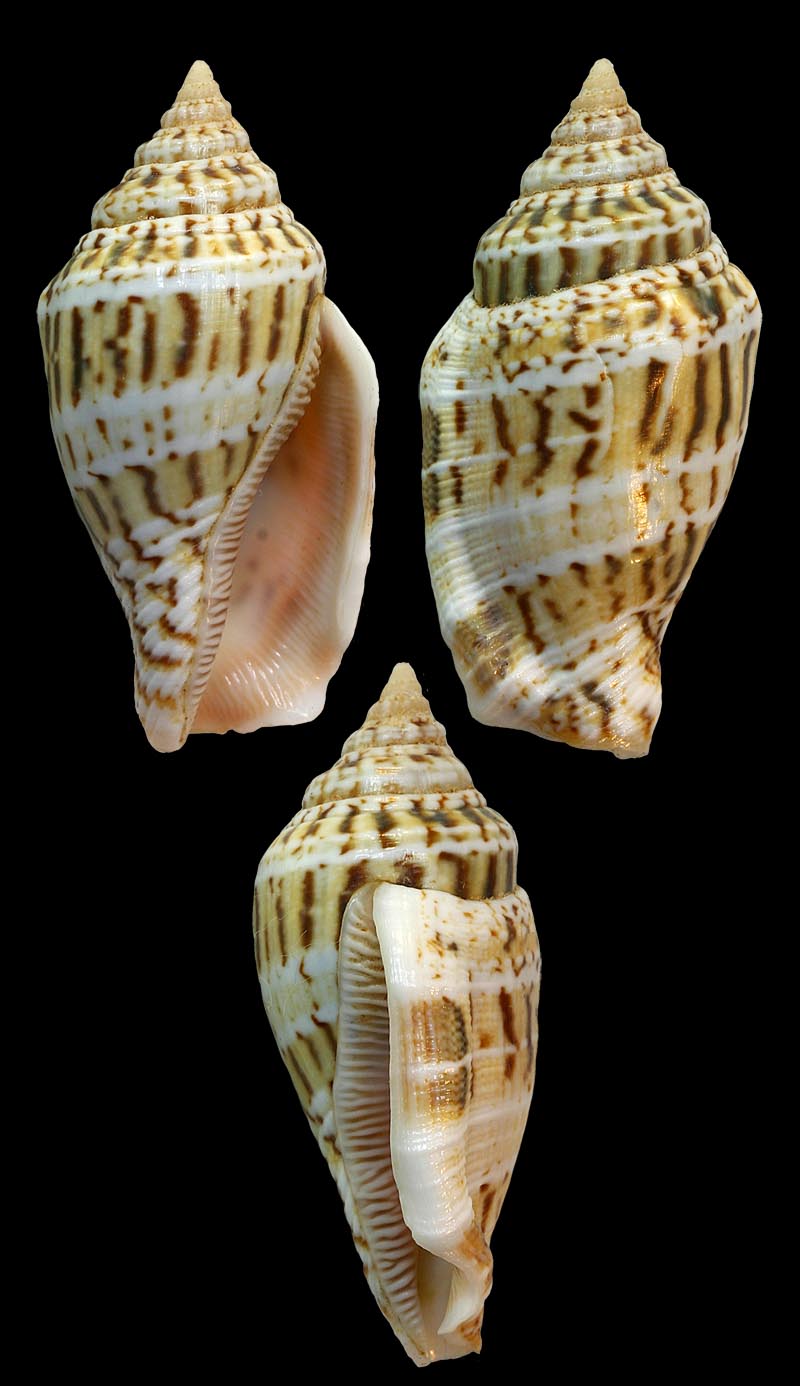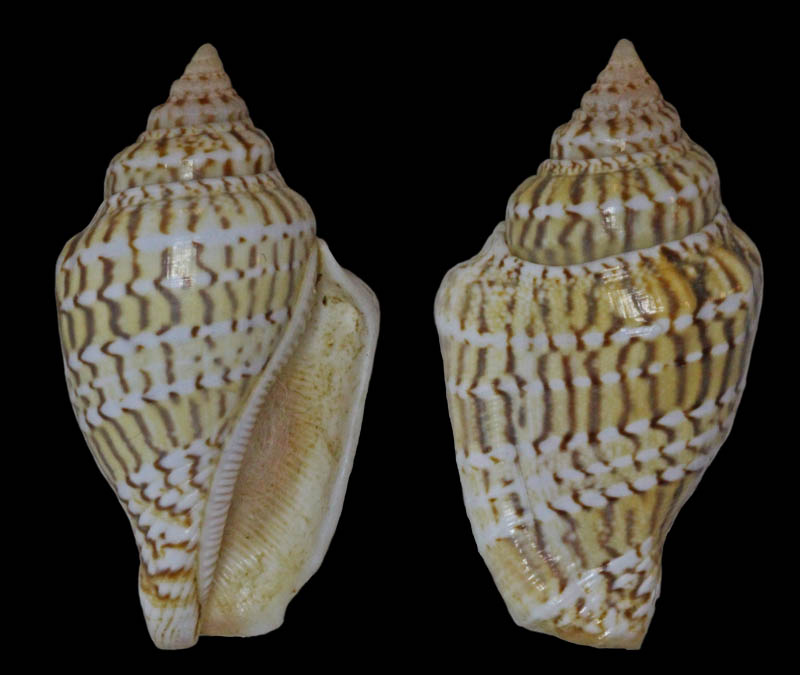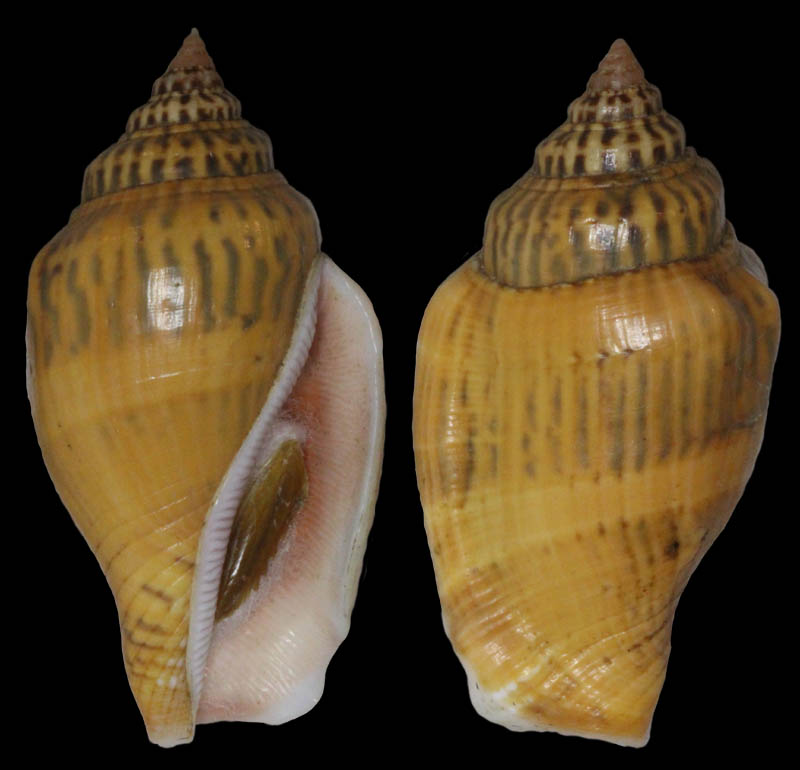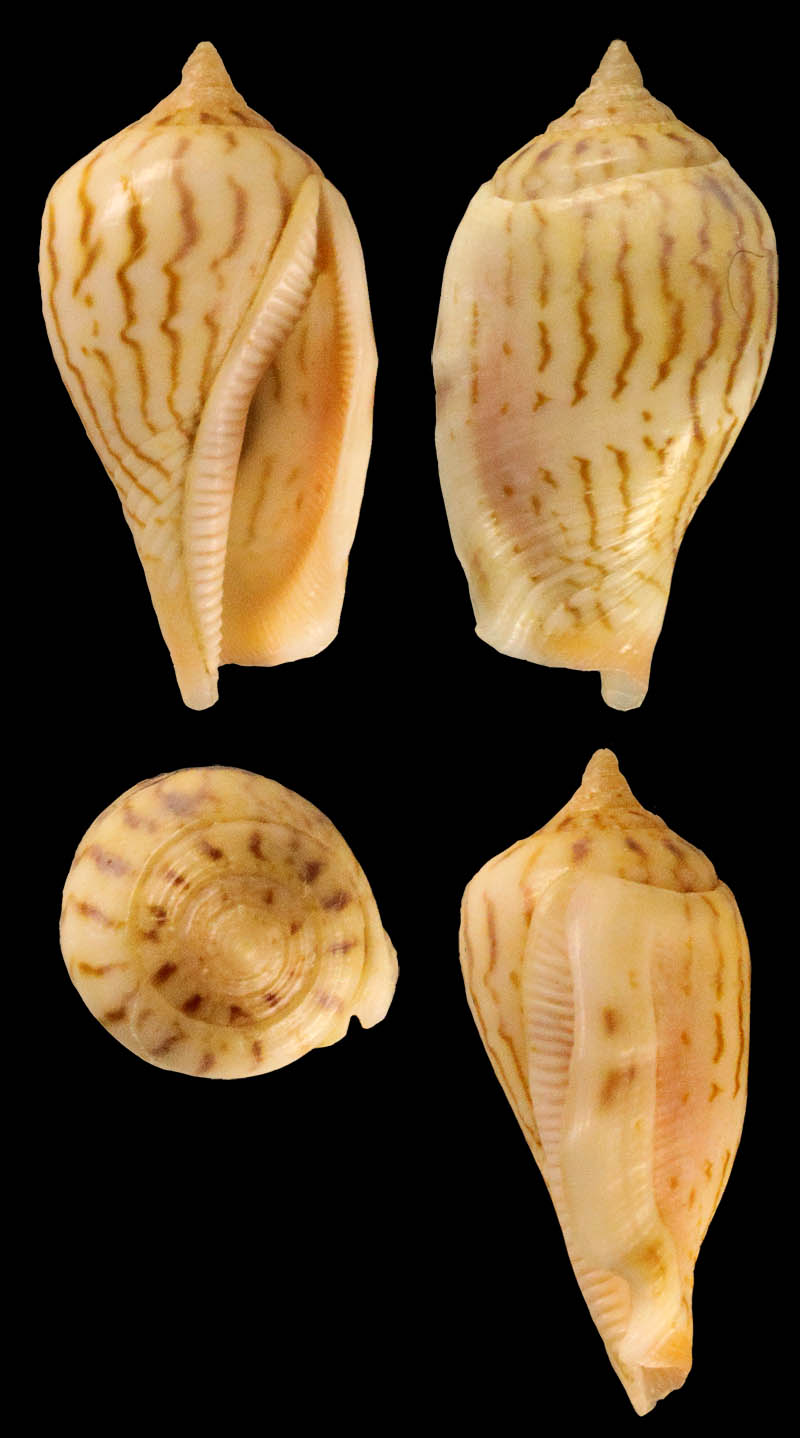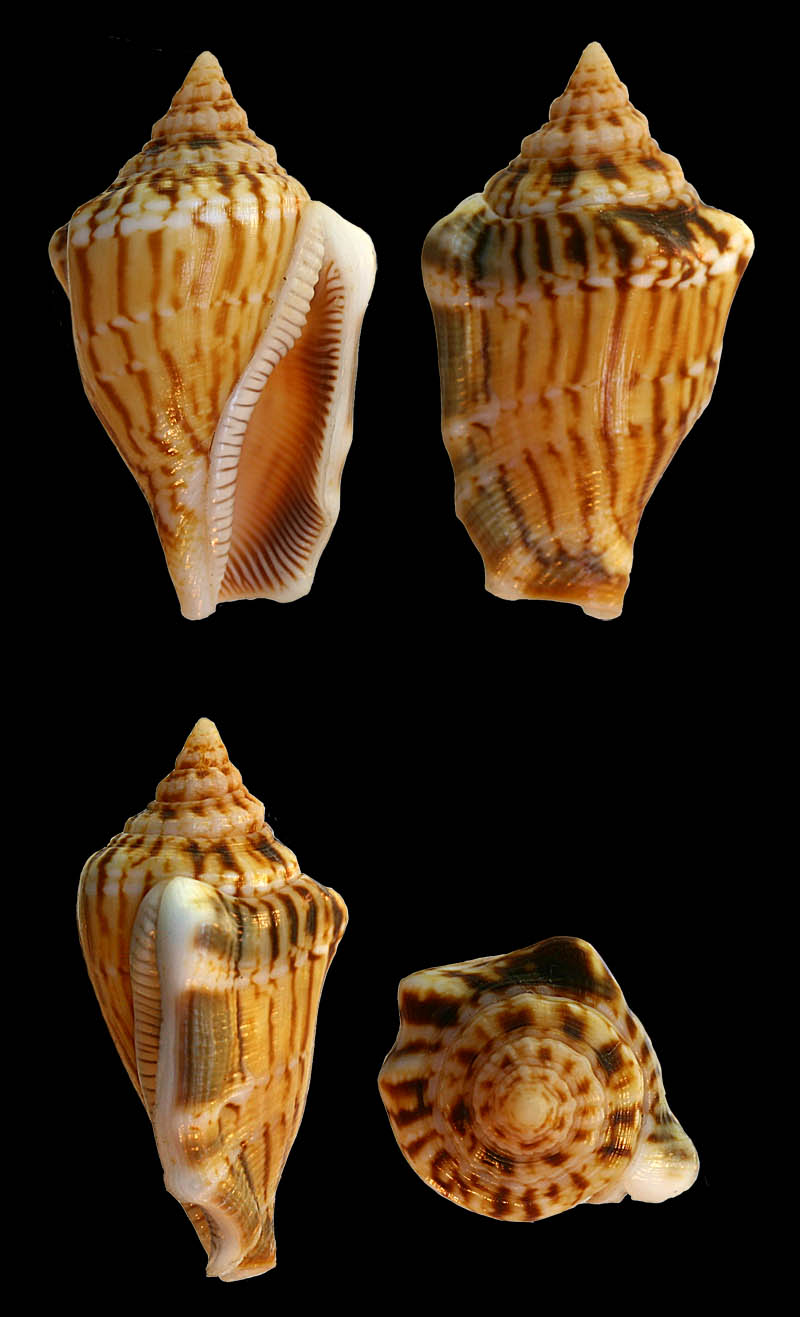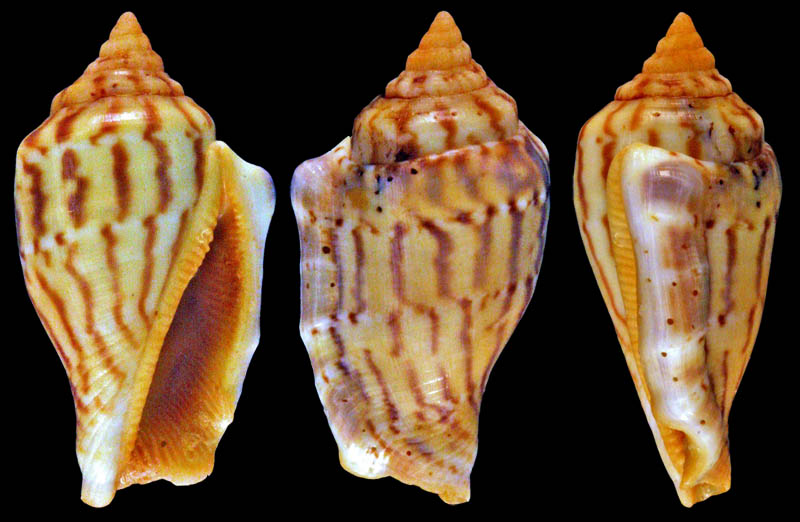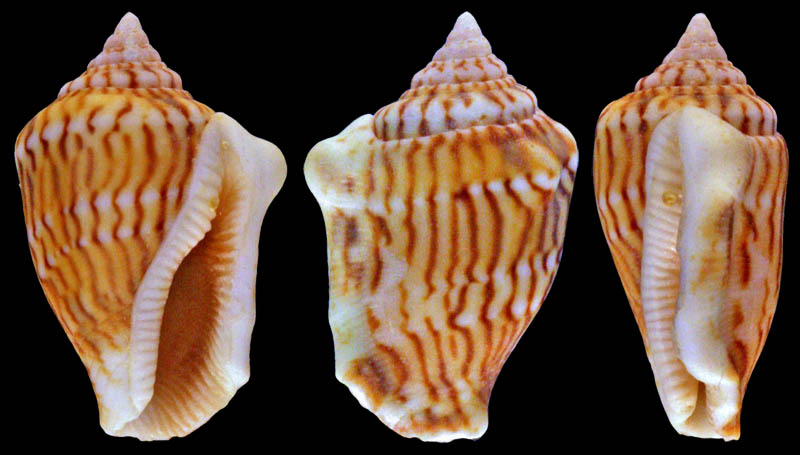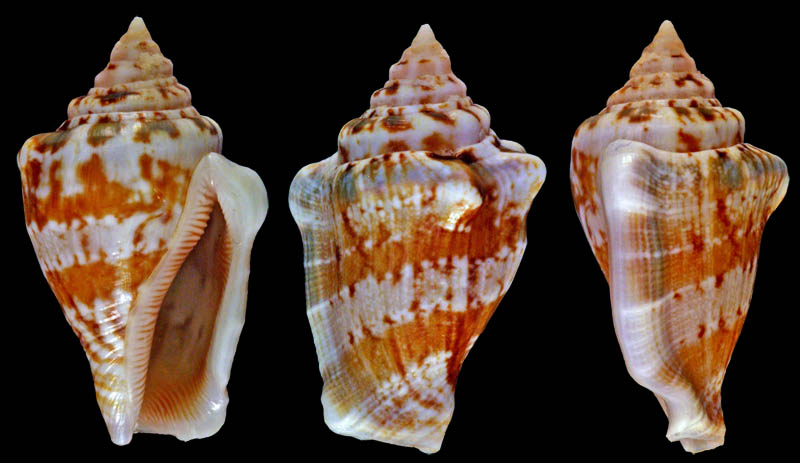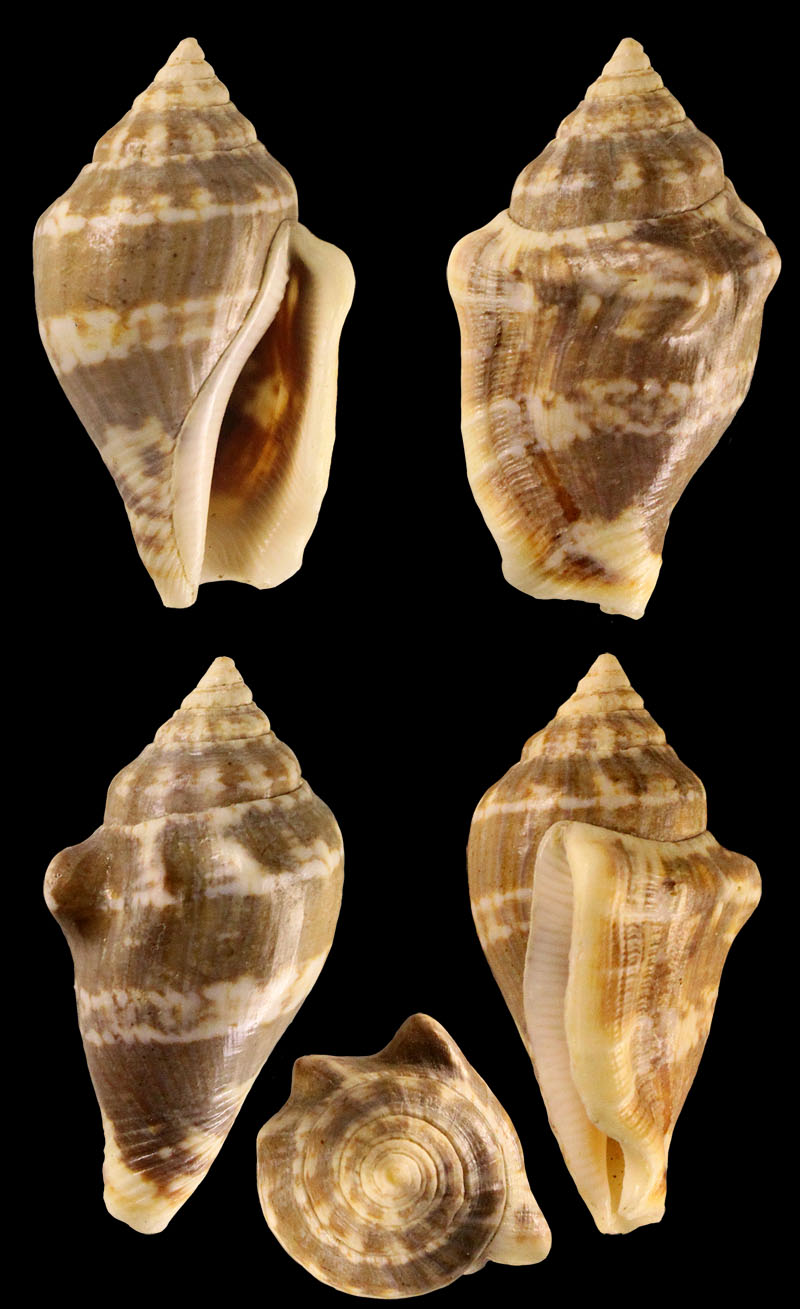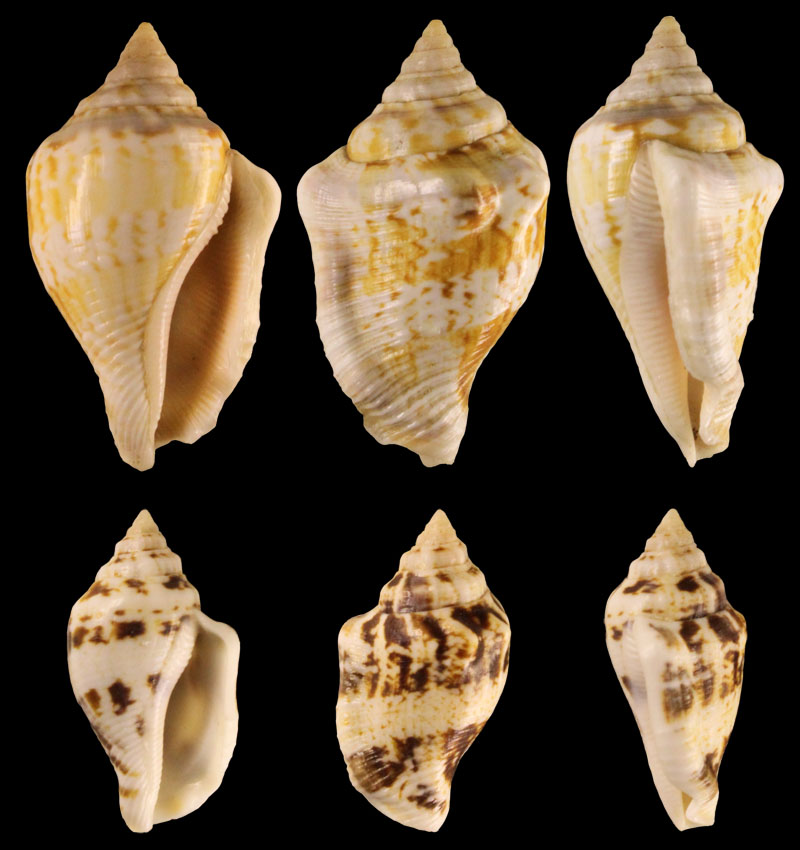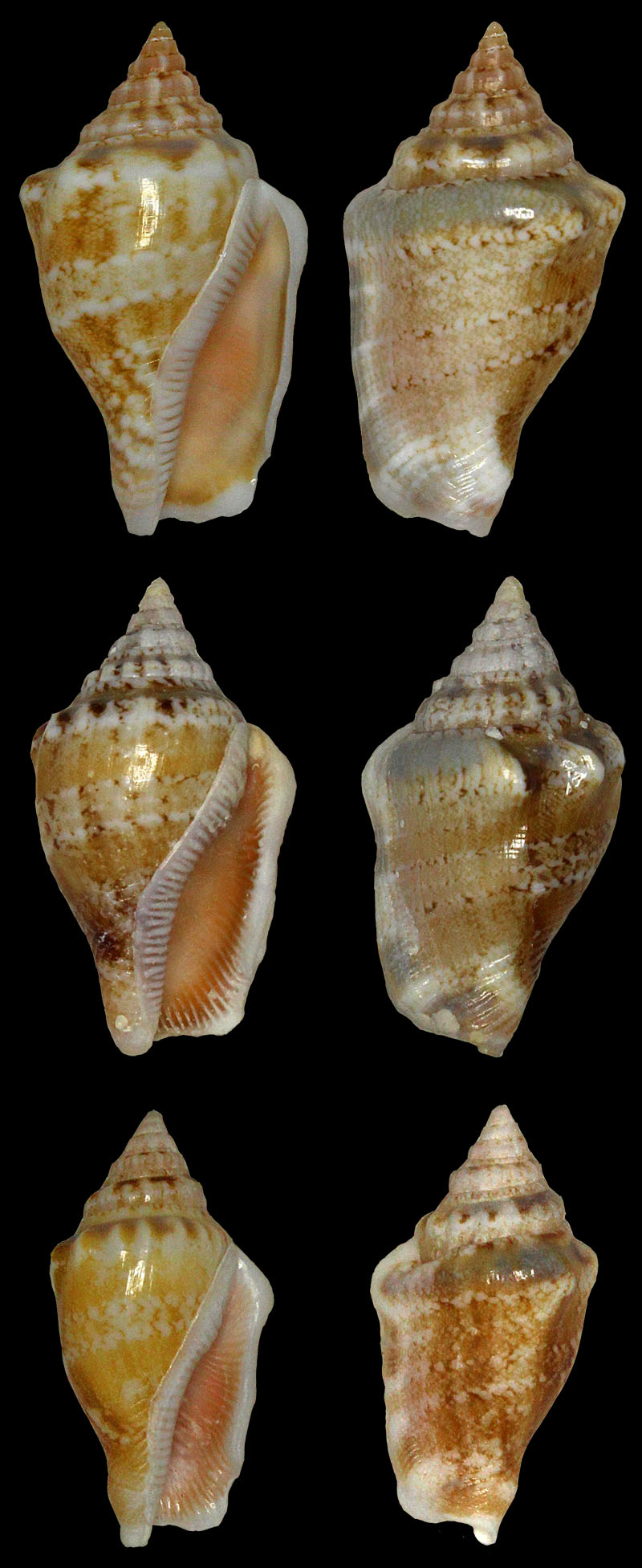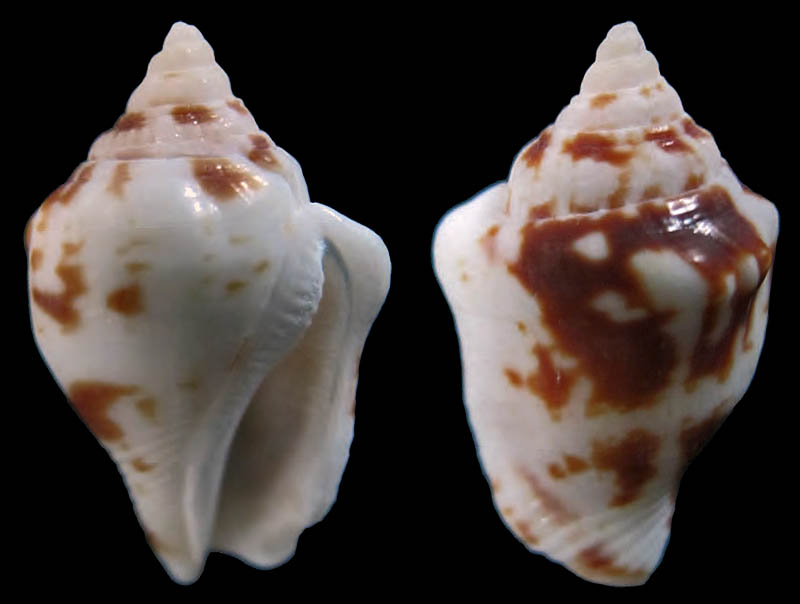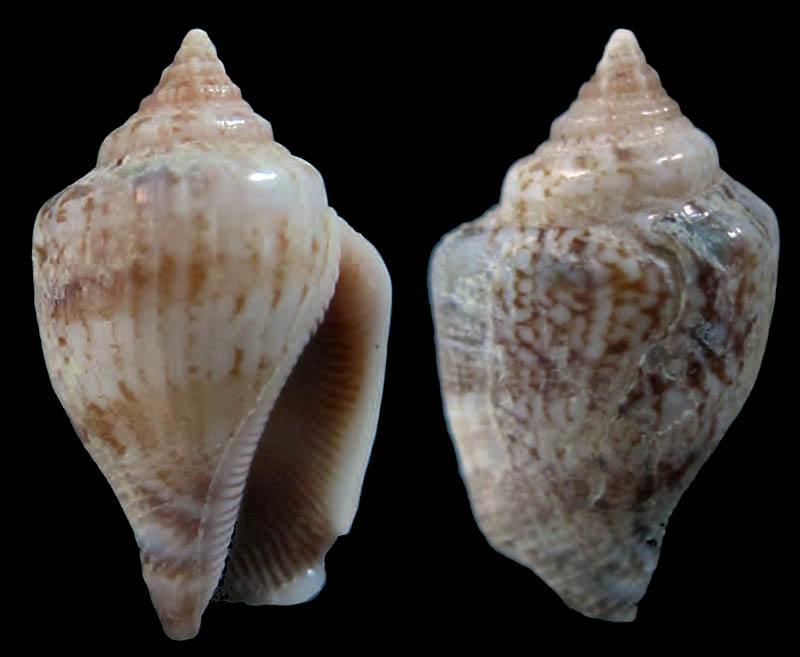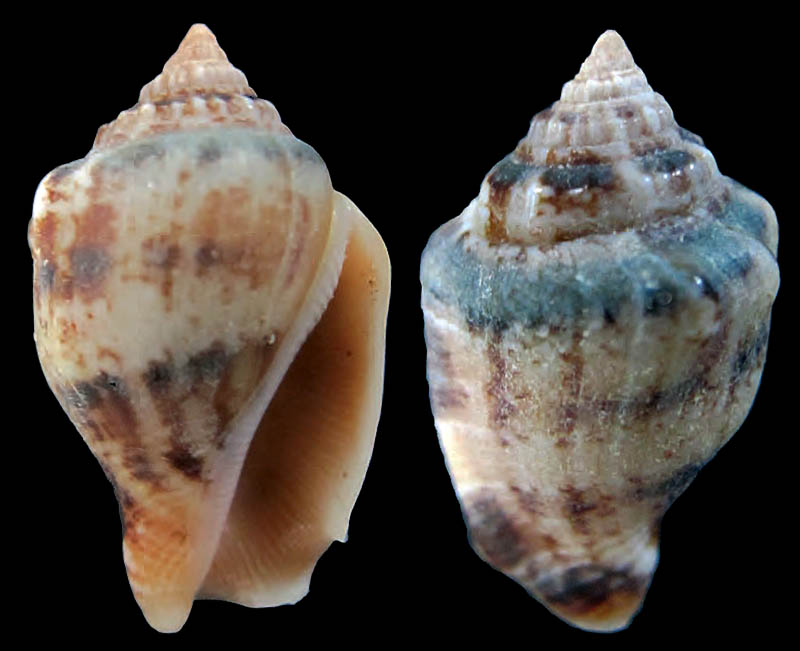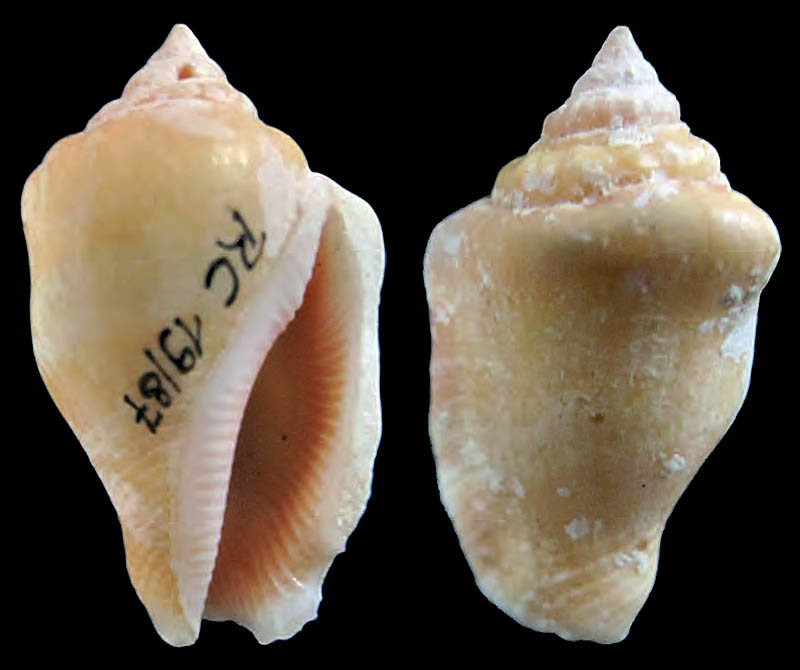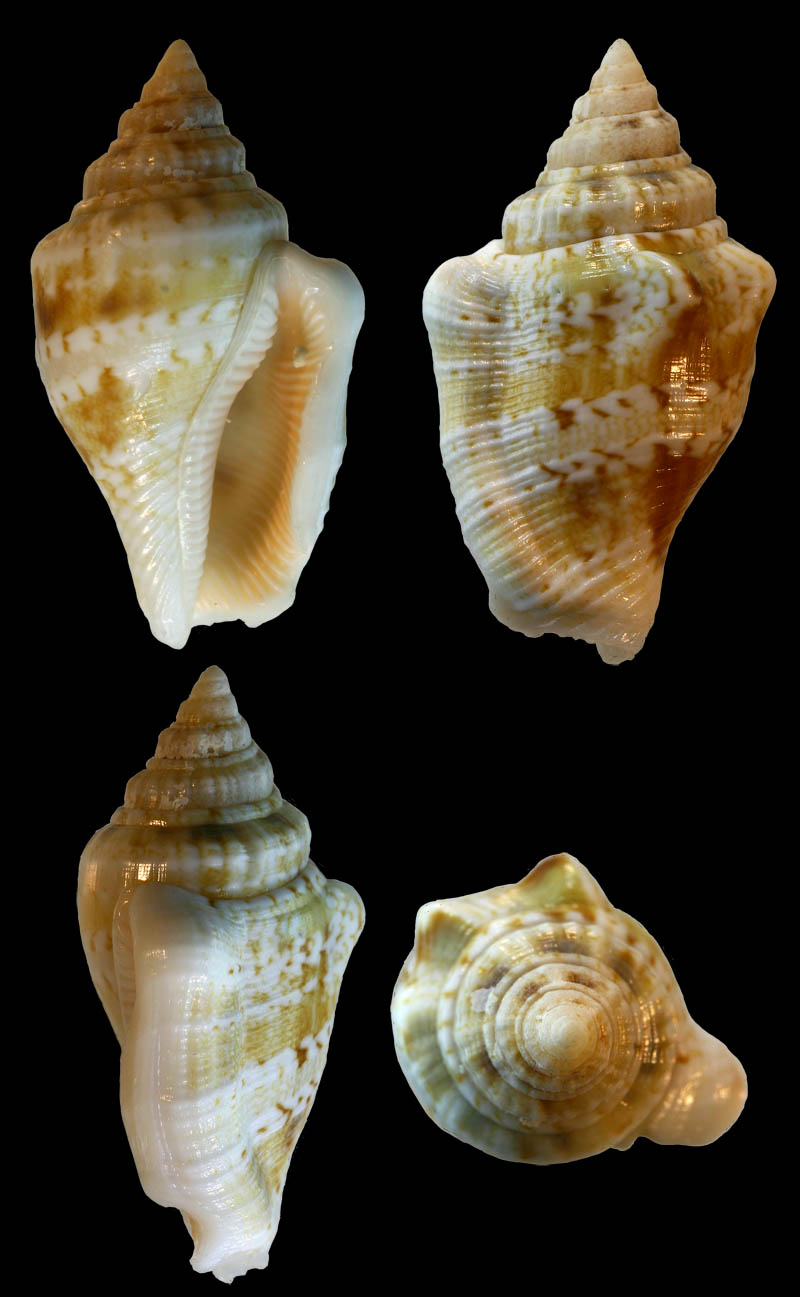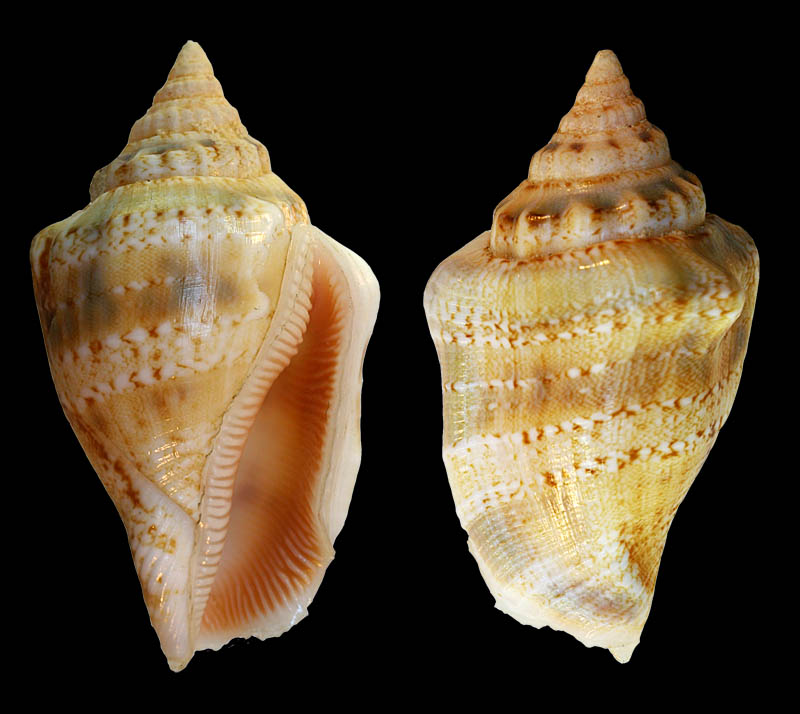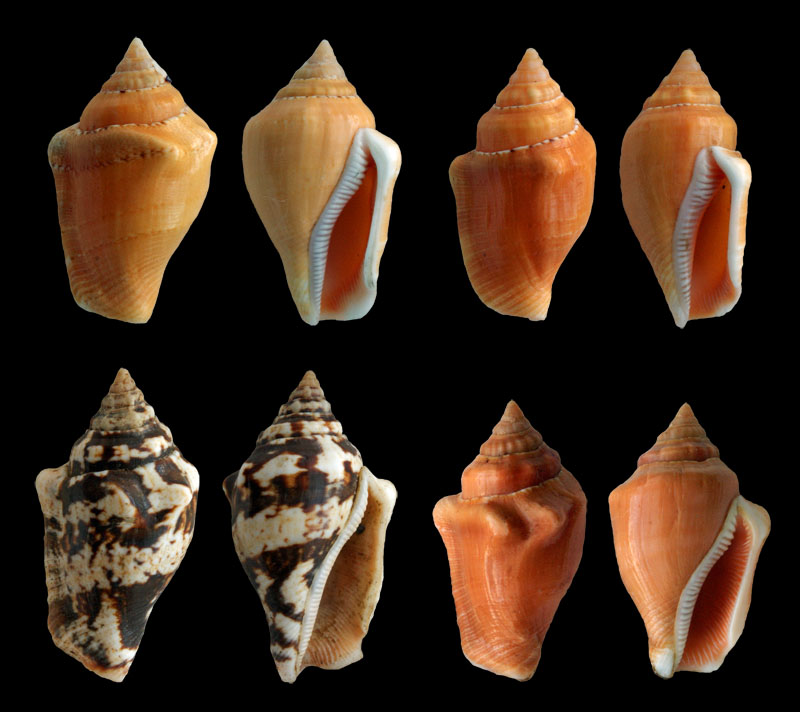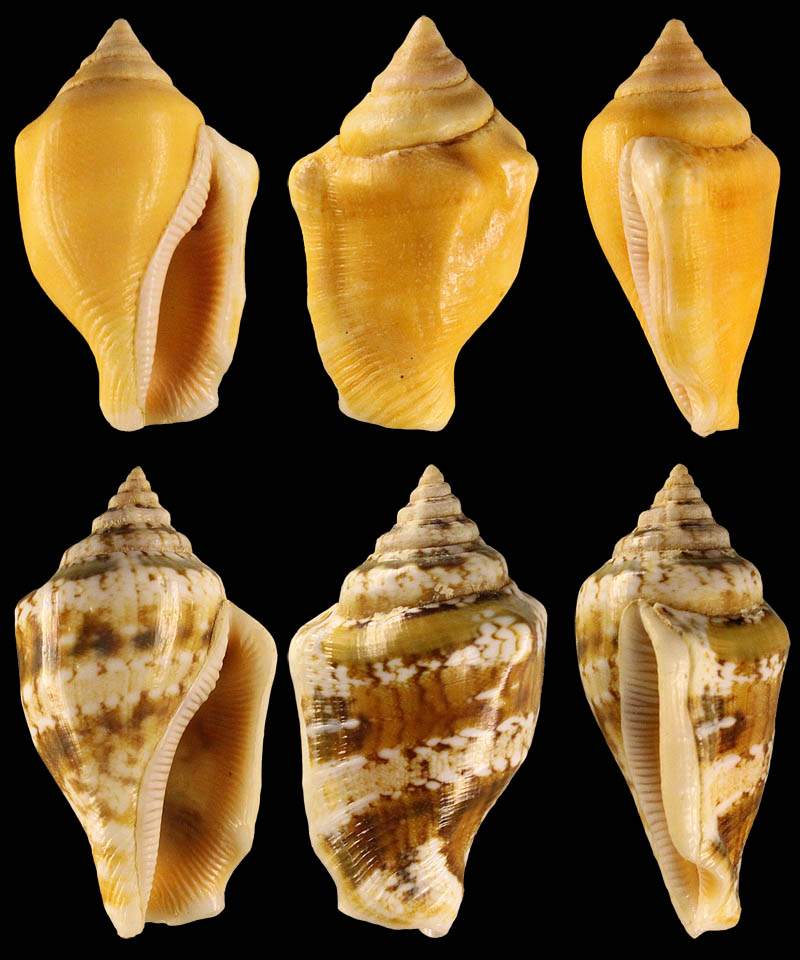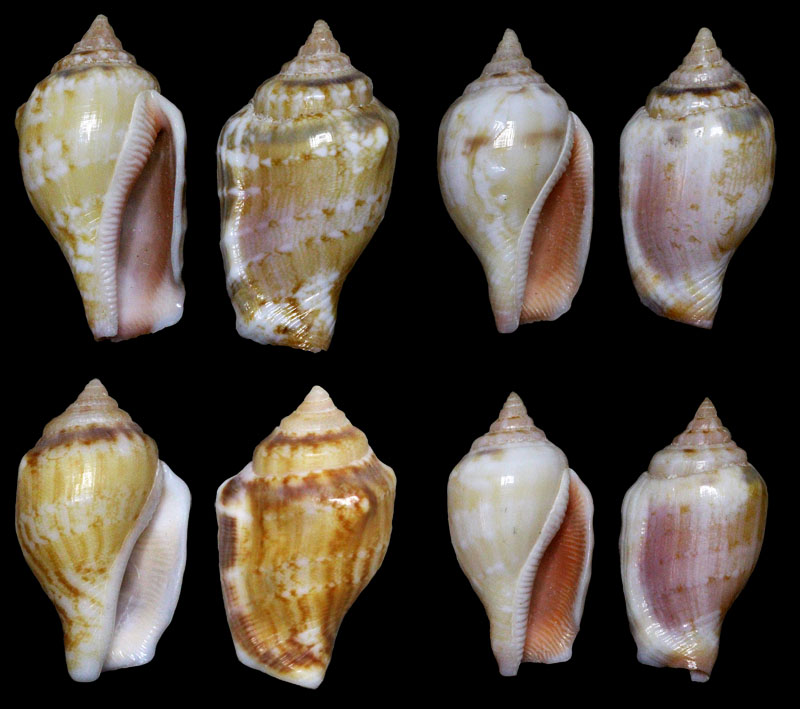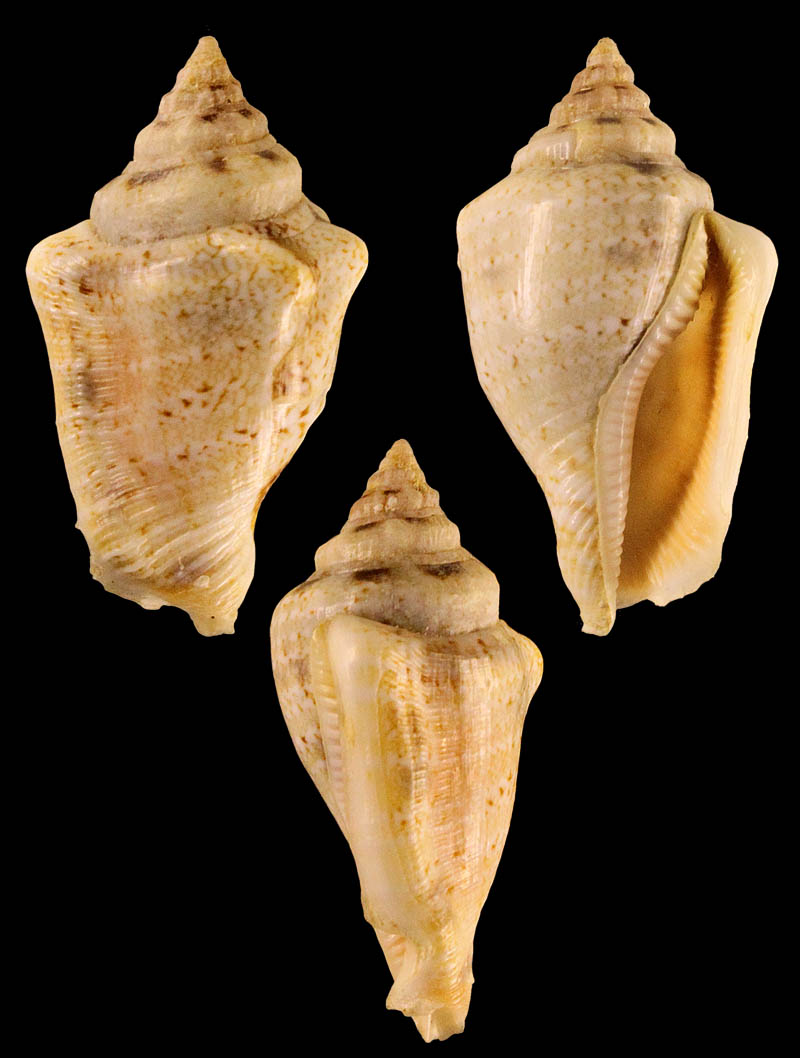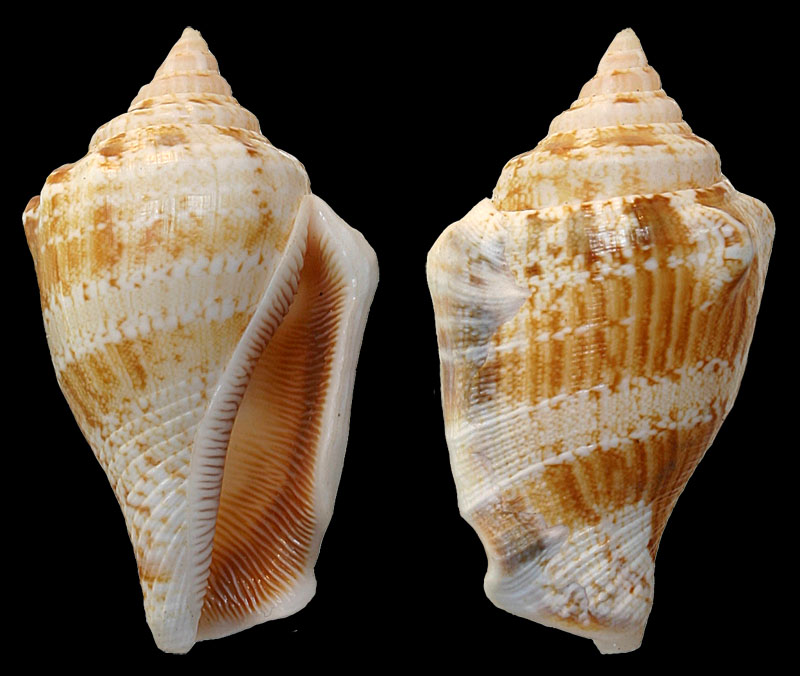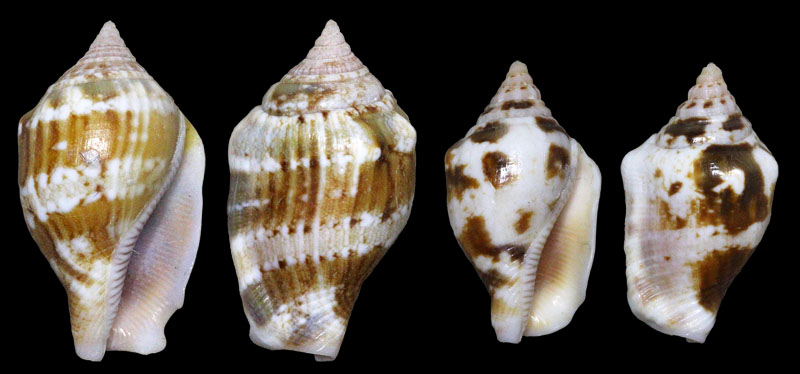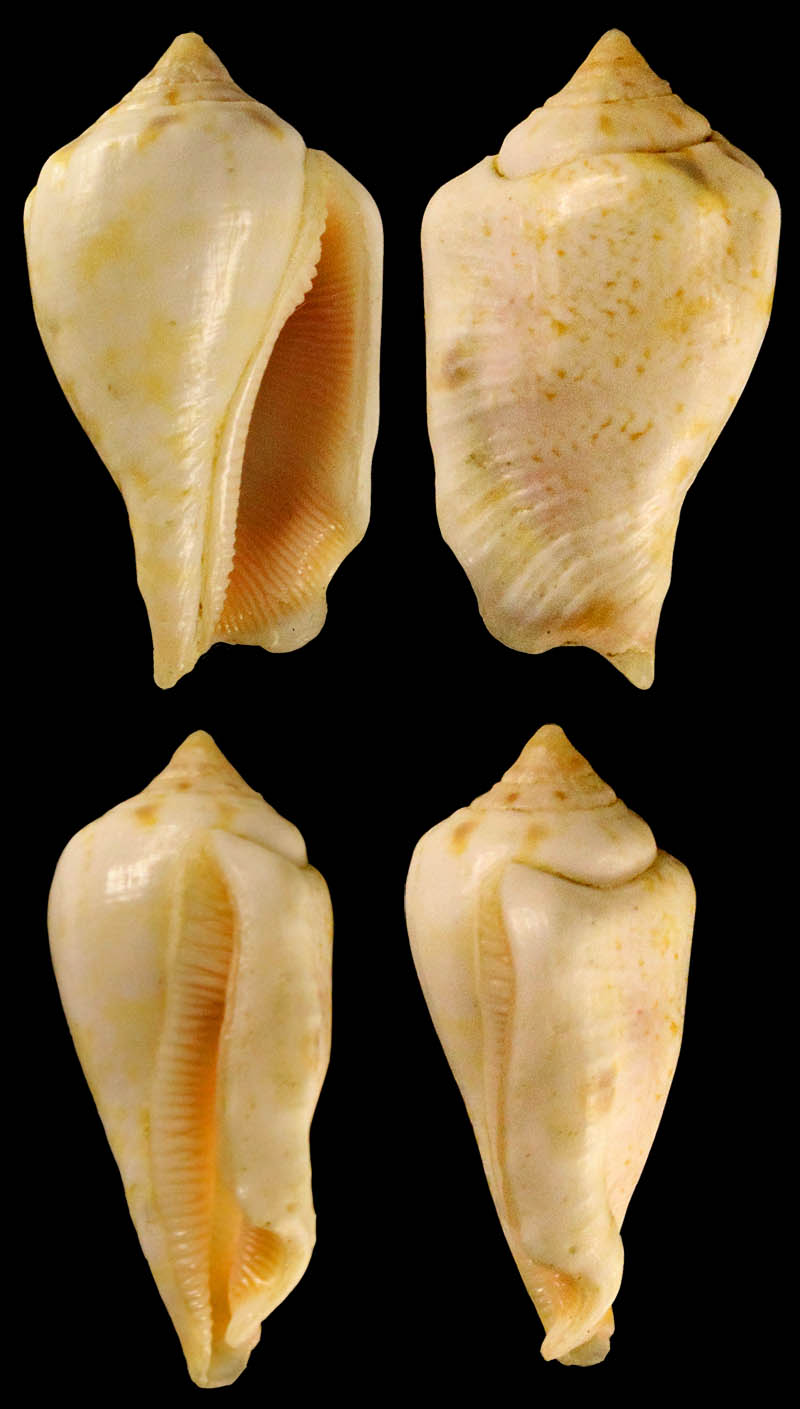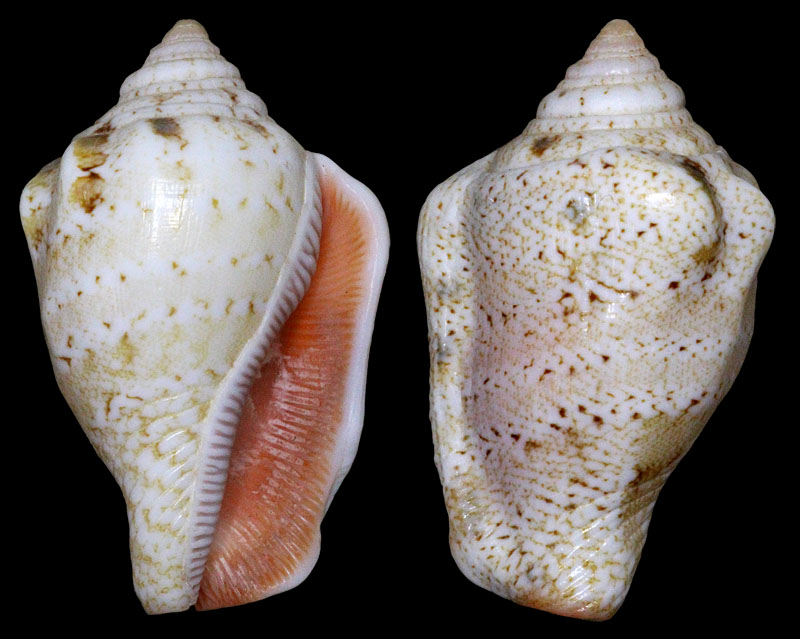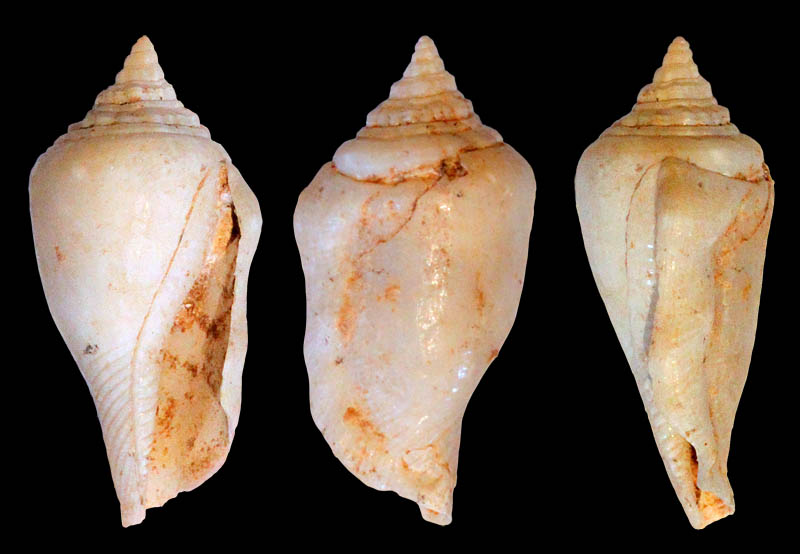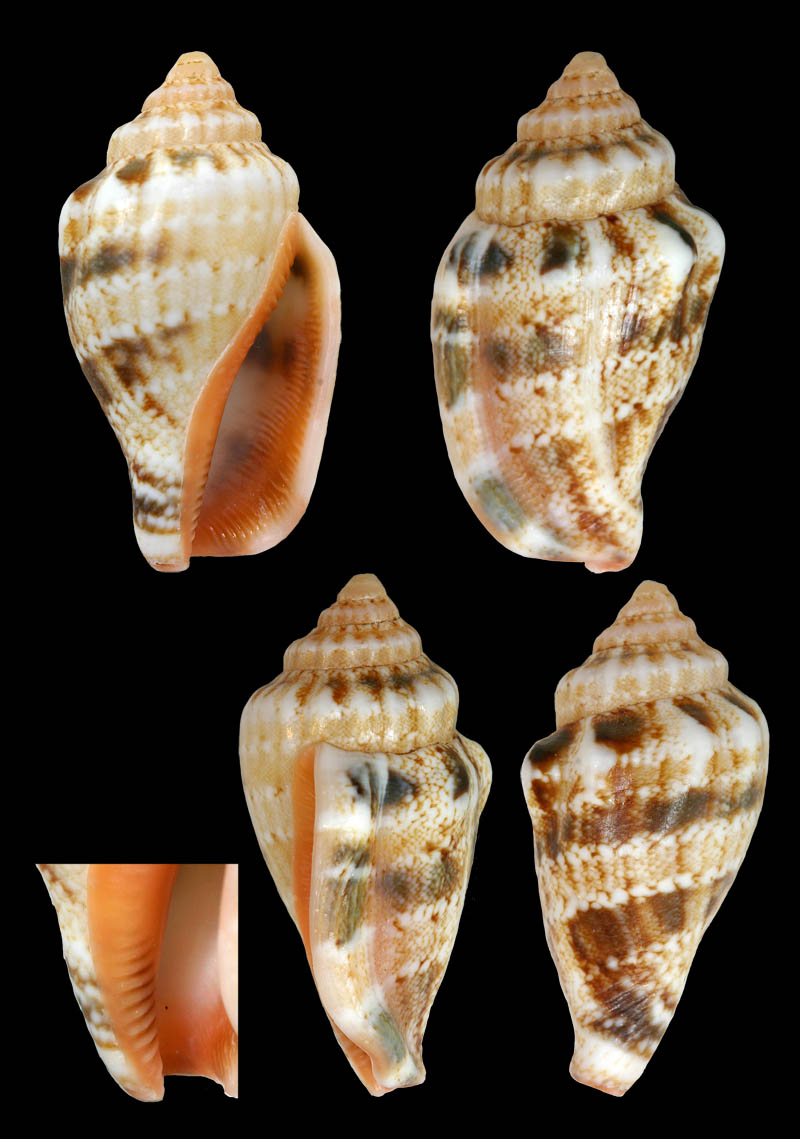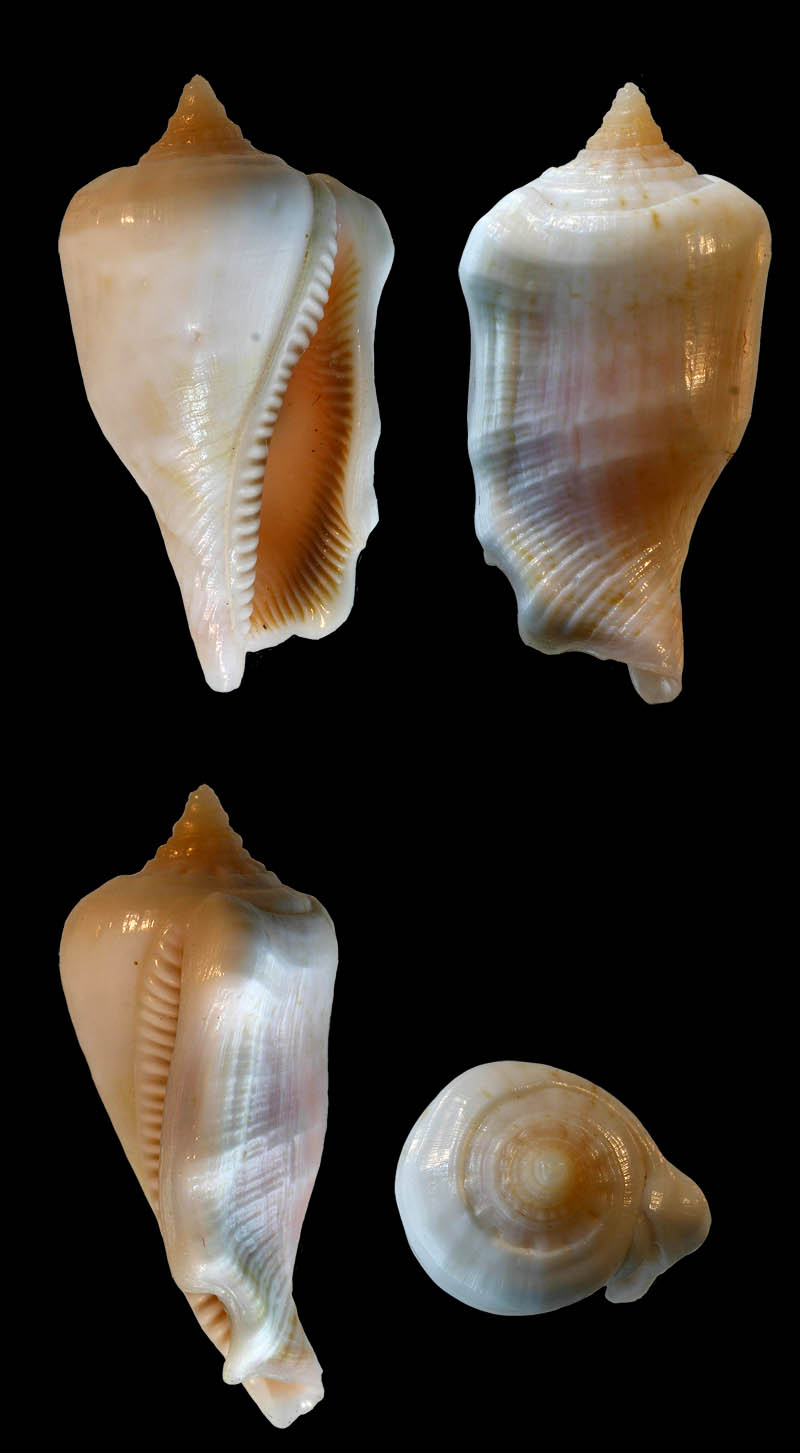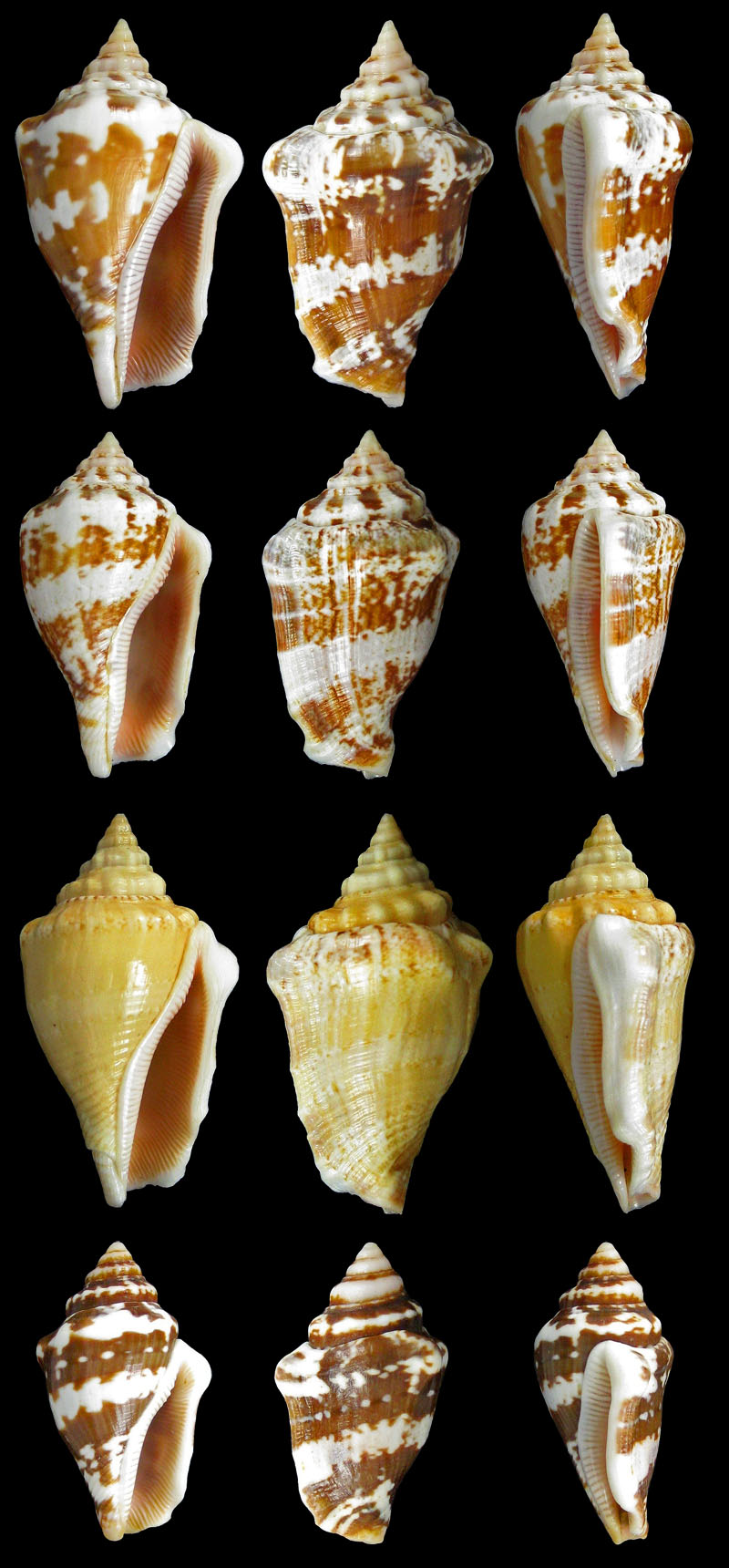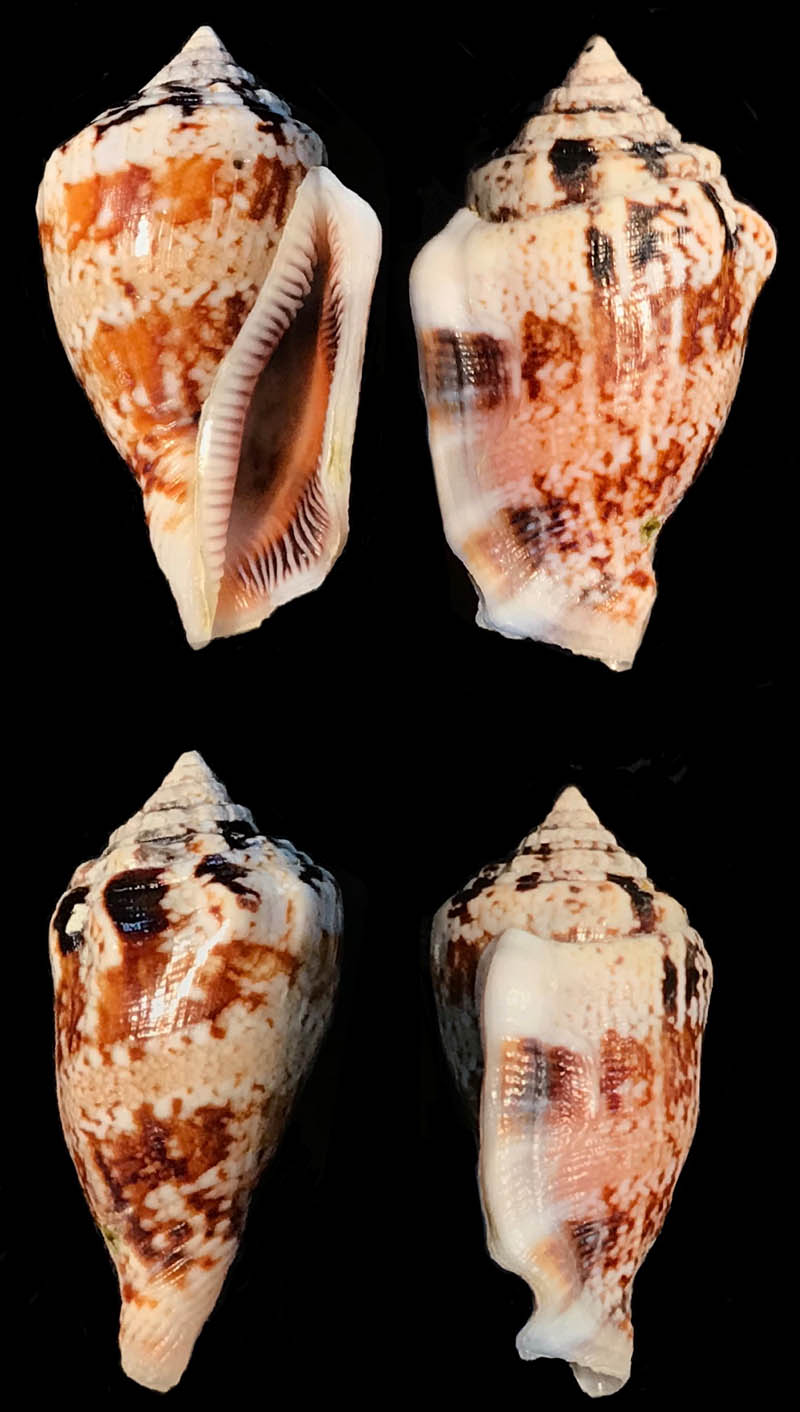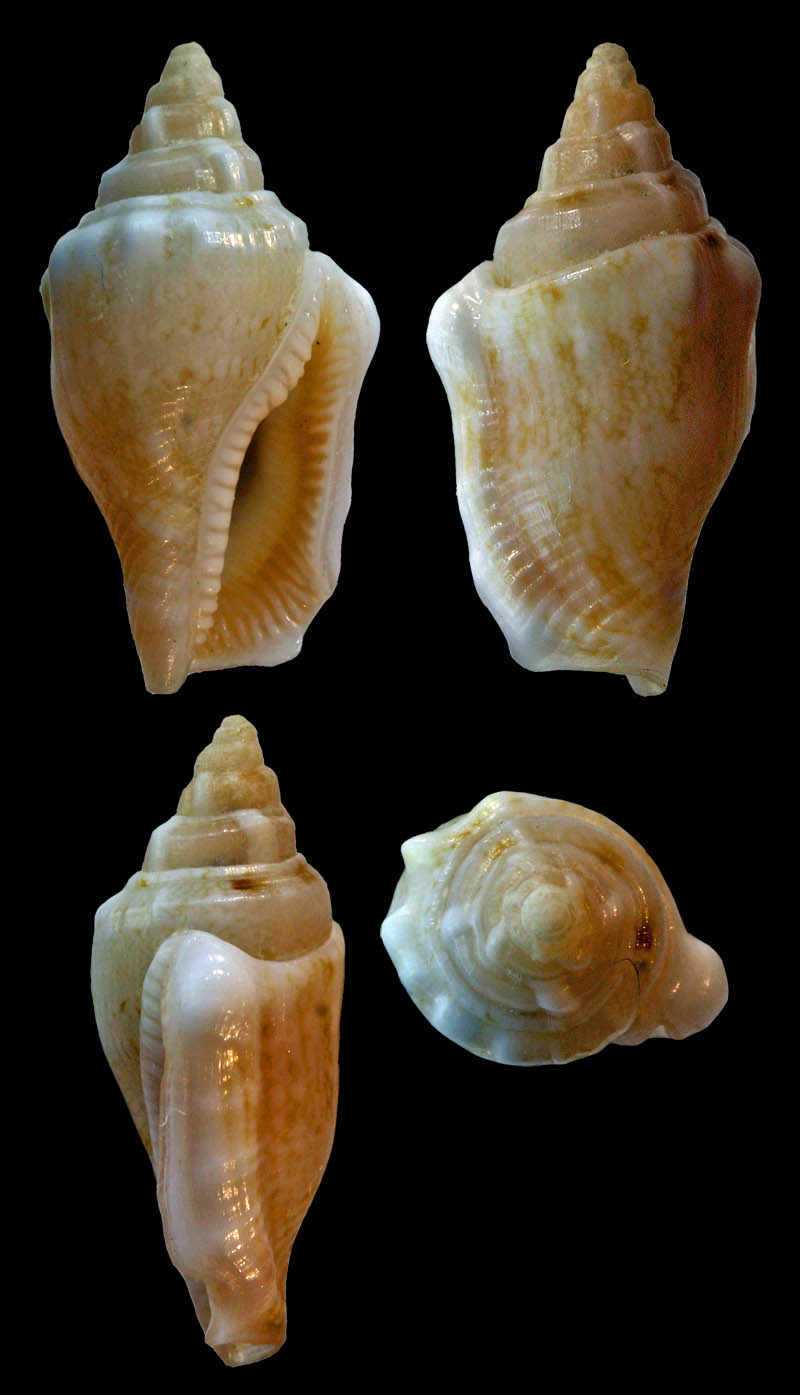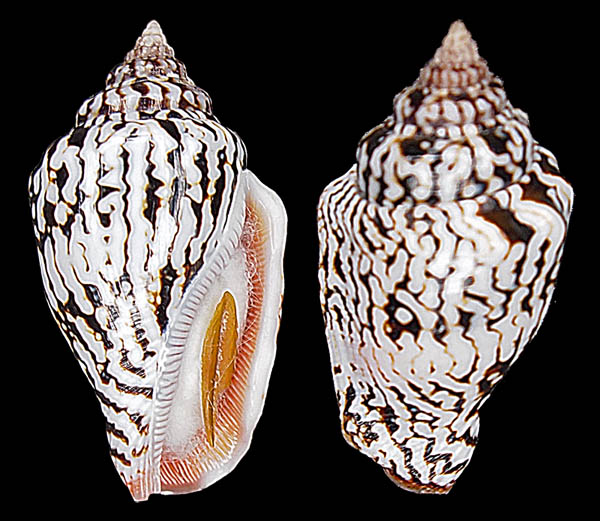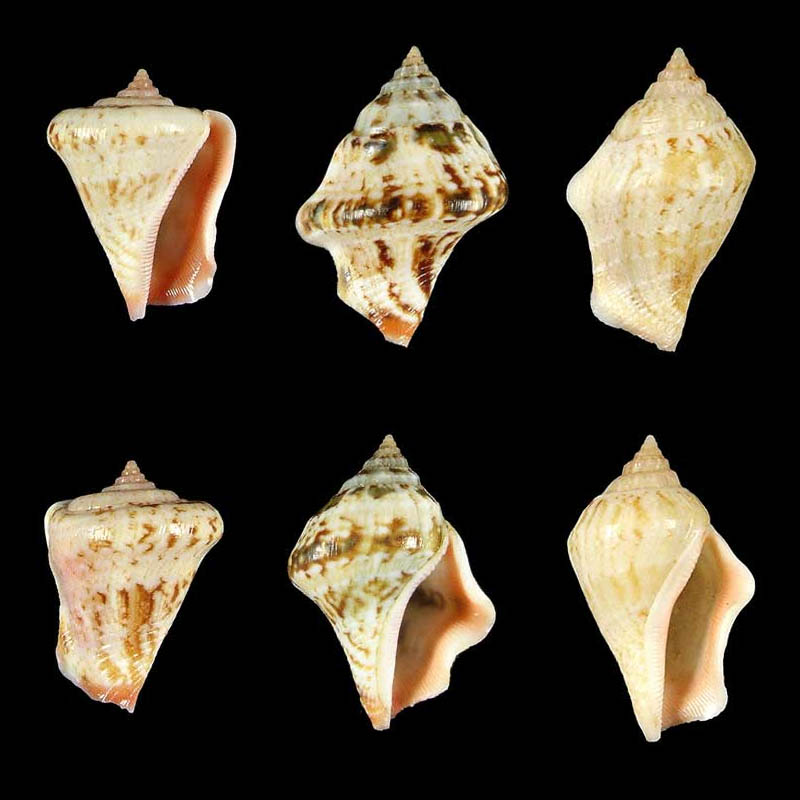|
edit SideBar
|
Species / Canarium Mutabile
Stromboidea
Original Description of Strombus mutabilis by Swainson, 1821:
- "S. anfractu basali nodoso; spira brevi tantum non laevi; linea sulcata suturae parallela; labio exteriore supra gibbo, margine recto, interiore crasso, cum exteriore striato; apertura pallida rubicunda, basi truncata."
- "Basal whirl nodulous; spire short, nearly smooth, with a sulcated line parallel with the suture; outer lip above gibbous, the margin straight; inner lip thick, both striated; aperture flesh colour; base truncated."
Locus typicus: East Indies (Swainson, 1821), Abbott, 1960, p. 74: "Cebu City, Cebu Island, Philippines"
Stratum typicum: recent
Types: "The whereabouts of Swainson's type of mutabilis is unknown." (Abbott, 1960, p. 74)
Strombus mutabilis Swainson, 1821, pl. 71, fig. 1, 4
Swainson, 1821 cites:
- Seba, tab. 61, fig. 26, 27, 32, 33, 54; tab. 62, fig. 42, 43(?)
- Martini 3, tab. 77, 799, fig. 78, 807
- Knorr 2, 14, fig. 3
- Rumphius 37, W
History and Synonymy
Canarium mutabile (Swainson, 1821: pl. 71) (Strombus)
- Syn.: Conarium [sic!] mutabilis Sw. Jousseaume, 1888: 174 [in Muricidae]
- Syn.: Strombus epimellus Duclos in Chenu, 1844: 3, pl. 16 figs 11-12, pl. 22 figs 5-6.
- Syn.: Strombus (Canarium) flammeus Link, Issel & Tapparone Canefri, 1876: 346
- Syn.: Strombus floridus Lamarck, 1822: 211
- ? Syn.: Strombus floridus var. minima Sowerby 1st, 1825: 68 [non Linnaeus, 1771]
- Syn.: Strombus flosculosus Mörch, 1852: 63
- Syn.: Strombus mutabilis citrinus auct. [probably nom. nud., not available]
- Syn.: Strombus (Canarium) mutabilis form mutica Romagna-Manoja, 1980b: 15 [unavailable; published as a varietal name after 1960, ICZN art. 15.2]
- Syn.: Strombus (Canarium) mutabilis forma rufescens Prelle, 2006: 16 [unavailable; published as a varietal name after 1960, ICZN art. 15.2]
- Syn.: Strombus floridus form zebriolatus Adam & Leloup, 1938: 117, pl. 1 fig. 7
- ? Syn.: Strombus ostergaardi Pilsbry, 1920 [1921]:320, pl. 12, fig. 27, 28
1688
Lister, 1688, pl. 848, fig. 3
Lister, 1688, pl. 859, fig. 15
- cited by Lamarck, 1822 as Strombus floridus. Is not Canarium mutabile, Dolomena minima is shown.
1757
Knorr, 1757, vol. 2, 2, pl. XIV, fig. 3
1766
Canarium var 5 in Rumphius, 1766, pl. XXXVII, fig. W
1777
Martini, 1777, pl. 77, fig. 799
Martini, 1777, pl. 78, fig. 807, 808, 809
- fig. 807 cited by Swainson, 1821; fig. 807-809 cited by Lamarck, 1822
1822
Original Description of Strombus floridus by Lamarck, 1822, p. 211:
- "27. Strombe fleuri. Strombus floridus. St. testa ovato-acuta, supra labrum infernèque striata, coloribus variis picta; ultimo anfractu antice tuberculifero; spira brevi, longitudinaliter subplicata; fauce striata, rubente."
Lamarck, 1822, p.211 cited
- Lister, Conch. t. 848. f.3. et t. 859. f. 15.
- Rumph. Mus. t. 37. fig. W.
- Petiv. Amb. t. 14. f. 20.
- Seba, Mus. 3. t. 61. f. 26. 27. 32. 33. 40. 48. 50. 54. 65. et t. 62. f. 42. 43.
- Martini, Conch. 3. t. 78. f. 807-809.
Lamarck, 1822, p. 211:
- "Habite l'Océan indien et des Moluques. Mon cabinet. Coquille ventrue, tuberculeuse, et très-variée dans sa coloration. Longueur, 17 lignes."
1825
Sowerby (I), 1825, p. 68 on Strombus mutabilis var. minima:
- "1782 [catalogue accession number] - [Strombus] floridus, St. mutabilis, Swains. (a) var. minima"
1828
Strombus floridus in Wood, 1828, pl. 4, fig. 5
1843
Strombe fleuri (Strombus floridus Lam.) in Kiener 1843, pl.32, fig. 1
Strombe fleuri (Strombus floridus Lam.) in Kiener 1843, pl.32, fig. 1 a, 1 b, 1 c
Kiener, 1843, p. 63 cited
- Lister, Conch., t. 848, fig. 3
Description of Strombus floridus by Kiener, 1843, p. 63:
- "St. testa ovato-acuta, supra labrum infernéque striata, coloribus variis picta; ultimo anfractu anticè tuberculifero; spira brevi, longitudinaliter subplicata; fauce striata, rubente."
- "Coquille ovale, conique, à spire peu élevée, à peine étagée; elle se compose de six ou sept tours convexes et subanguleux, portant sur l'angle une rangée de tubercules; ces tubercules, très-petits sur les premiers tours, tendent à disparaître sur l'avant-dernier; ils se montrent de nouveau sur le dernier, mais seulement au nombre de trois à cinq et d'un aspect très-gros, noduleux, irrégulier; le plus fort occupe la partie dorsale du tour; l'extrémité inférieure de celui-ci est dépourvue de tubercules et un peu aplatie; la surface de la coquille est couverte de stries transverses plus visibles à la base. L'ouverture est allongée, un peu évasée à sa partie inférieure, se prolongeant à son sommet en une petite gouttière formée par la réunion des deux bords; à l'extérieur, le bord droit est épaissi par une sorte de bourrelet longitudinal; il est un peu dilaté à sa base ou il offre un petit sinus, et légèrement infléchi à sa partie moyenne; sa face interne est pourvue sur toute son étendue de fines rides transverses; le bord gauche est épais, saillant, calleux, ridé comme le bord droit; le canal est très-court, large, tronqué à sa base. Cette coquille, d'un fond blanchâtre, est parsemée de maculations brunes ou noires, formant tantôt des marbrures, tantôt des flammules, quelquefois des fascies. L'ouverture est rose. Long. 40 millim. Habite la mer des Indes et des Moluques."
Comment Kiener, 1843, p. 64:
- "Ce Strombe présente une infinité de variétés de forme et de coloration; nous en avons fait représenter trois sur notre même planche 32 (voir les fig. 1a, 1b, 1c), la dernière est d'une couleur uniforme d'un jaune orangé. C'est d'ailleurs une espèce très-commune et facile à distinguer."
1844
Strombus epimellus in Duclos, 1844, pl. 16, fig. 11, 12
1850
Strombus floridus in Reeve, 1850, Strombus, pl. 7, fig. 11 a, b
Strombus floridus in Reeve, 1850, Strombus, pl. 7, fig. 11 c, d
1852
Mörch, 1852, p. 63 on Strombus flosculosus:
Mörch, 1852, p. 63 referenced as synonyms:
- A. gibberulus Meusch.
- L. flammea Link.
- S. floridus Lam.
1871
Lischke, 1871, p. 23 described Strombus floridus from Japan.
Comment Wieneke: This is Canarium microurceus
1921
Original Description of Strombus ostergaardi by Pilsbry, 1920 [1921], p. 320:
- "The shell is somewhat pear-shaped, rather solid, white in the only examples known, which are long-dead shells. The rather short spire is concavely conic. In the most perfect example the penult whorl is weakly angular above the suture, with very weak, coarse nodes; the next earlier whorl is distinctly angular and tuberculate; above this the tubercles become closer, longer, so that the next two whorls are costate. The conic summit, of about 3 convex whorls, is smooth. The last whorl is very slightly compressed between face and back. It is slightly swollen behind the outer lip, somewhat flattened preceding the swelling, on the ventral face strongly convex above. It is smooth except for oblique grooves around the lower part and more or less distinct spiral threads near the lip. The suture descends in the last third of a whorl, ascending a little at its termination. The aperture is narrow. Outer lip not excavated posteriorly, having a moderate sinus anteriorly; closely lirate within. The inner lip is thick, with well defined edge, and is regularly lirate throughout."
Dimensions: fig. 27: "Length 24.5, diameter 12 mm."; fig. 28: "Length 31, diameter 16 mm."
Localities: "Honolulu Harbor, from the dredger dump on the Harbor side of Sand Island, J. M. Ostergaard. Also from the Kailua coast, on the north side of Oahu, W. A. Bryan."
Comment Pilsbry, 1921, p. 321:
- "This species is less distorted than S. gibberulus L., with a lirate columellar callus, and no excavation of the outer lip posteriorly. S. bulbulus Sowb. is more closely related, but it has a smooth, thinner and less extended columellar callus, and smooth, convex whorls of the spire. While the specimens have the appearance of fossils, it is likely that the species is still to be found living. The single one before me from Kailua is 21.3 mm. long, and has the short spiral threads over the swelling behind the lip more distinct. In the largest specimen there seems to be but one nodulose intermediate whorl of the spire, the whorls having the usual impressed spiral line below the suture; but as the spire is quite short, the nodules may be concealed by the enveloping whorls. The sculpture of the spire described above is therefore not a constant feature.
Etymology: "This stromb was first found by Mr. Ostergaard in 1905. Subsequently he found three more."
Strombus ostergaardi Pilsbry, 1920 [1921],pl. 12, fig. 27-28
1933
Original Description of Strombus (Canarium) floridus depauperata by Dautzenberg & Bouge 1933, p. 296:
- "Cette variété diffère du Str. floridus par sa forme plus allongée, sa spire plus courte, l'absence de tubercules sur le haut du dernier tour, le bourrelet externe de son labre moins développé et enfin par sa coloration blanche ou jaunâtre avec cinq bandes transversales de petites taches d'un roux très clair. L'intérieur de son ouverture est blanc et non pas rosé comme celle du floridus."
- Locus typicus: Makatea!; Apataki!; Motutunga!.
1949
Abbott, 1949, p. 58:
- "In 1945, I collected several hundred specimens of small Strombus at the north end of Agana Bay, Guam Island, Marianas. The shallow, protected waters and the sand-mud bottom of this area are ideal for large, mixed colonies of S. gibberulus Linne and S. flammeus Link, 1807 (= floridus Lamarck, 1822). In the process of cleaning the shells, females were separated from males. The latter are easily recognized by the long, slender penis which is attached to the right side of the body. [...] The shell length of the males and females in each sample population was measured, and the results found in the two Guam colonies have been presented in the graphs shown below. It will be seen in the growth curves of Strombus flammeus Link in fig. B that the males are, on the average, smaller than the females. The distinct separation of the peaks of the growth curves is lost when the shell length of both females and males is plotted, as shown by the dotted line. The extent and overlapping of the range in size of the two sexes is such that the character of shell length cannot be used as an indication of sex. [...] It was noticed that in each of the three colonies there are fewer males than females. The percentage of males present in each sampling were [...] 40% (flammeus, Guam).
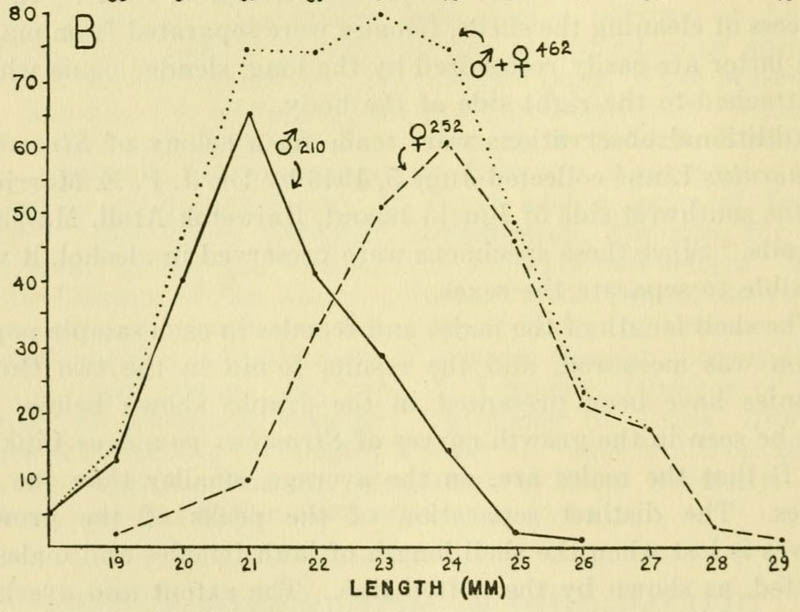 Fig. 1. Growth curves based on total shell length of male and female Strombus from Agana Bay,Guam Island, USA: S. flammeus Link.
1960
Ostergaard, 1960, p. 3:
- "Through recent information received, a wider range than heretofore known of Strombus ostergaardi has been established. Based on reliable data with specimens in my possession, the following localities have been ascertained: Marshall Islands, Okinawa, New Hebrides and Hawaii."
- "Oreba Island of the Kwajalein Atoll, Marshall Islands"
- "Surundu Bay, Espirito Santo, New Hebrides."
- "The species appears to be usually white throughout, but one cannot tell to what extent the original colors might have been lost in fossil shells. The shell from Okinawa is of a deep brown on its entire surface, as well as the striations of the aperture, while the margins of the lips are white. The shell from Kwajalein is milky white with pale pink striations on the aperture. The shell from the New Hebrides is milky white with faint brown bands on the outer lip."
1972
Strombus (Canarium) mutabilis in Ladd, 1972, pl. 15, fig. 10-15
Ladd, 1972, p. 58 on Strombus (Canarium) mutabilis Swainson:
- "Abundant (17 specimens) in the Ndalithoni Limestone (stations 110B, 110C) of Vanua Mbalavu, Fiji; age, Pliocene (Tertiary h). All the fossil shells from Fiji are smaller than most of the Holocene shells collected in Fiji. Measurements of the two figured specimens from station 110B are: USNM 648462 - length 11.9 mm, diameter 6.7 mm; USNM 648463 - length 13.9 mm, diameter 7.6 mm. Three well-preserved specimens were collected from the Mariana Limestone on Cabras Island off the west coast of Guam (USGS loc. 21591), and a single incomplete specimen was collected from the Mariana Limestone of Saipan (USGS loc. 17897); age of both occurrences, probably Pleistocene. Measurements of the figured specimen from Guam, USNM 648461: length 20.3 mm, diameter 19.1 mm. A single specimen from Eniwetok, drill hole EN-4, depth 2 feet in Holocene. Holocene shells are abundant on the existing reefs of Guam and have been collected from all parts of the Indo Pacific except Hawaii, the Line Islands, and the Marquesas. Fossil records include the Pliocene of the New Hebrides and Indonesia and the Pleistocene of Hawaii, the Red Sea, and Somalia."
2005
Kabasakal et al., 2005, p. 62:
- "Regarding Strombus mutabilis (SWAINSON, 1821), the origin of the species in the Mediterranean is much more clarified, as the the distributional area is included the Red Sea (DANCE 1992), as well as ZENETOS et al. (2003) reported doubtly this strombid gastropod as a possible Lessepsian immigrant."
2013
The "Invasive Species Compendium" lists Strombus mutabilis as invasive species in Israel, Mediterranean Sea. Cabi, 2013
DAISIE (Delivering Alien Invasive Species Inventories for Europe) lists Strombus mutabilis as invasive species in Israel, Mediterranean Sea DAISIE, 2013
Reports
Jeanette & Scott Johnson about Canarium mutabile from Kwajalein Atoll:
- "Canarium mutabile are abundant on very shallow lagoon and seaward reefs in the Marshalls, more common in the lagoons. They range from the intertidal down to at least 10m and can be found on sand, rubble, or hard reef substrate, or even in Halimeda plants. Most shells are mostly whitish in color, but a few, such as the ones figured below, can be quite pigmented."
All Photos of Kwajalein Atoll-specimens courtesy Scott & Jeanette Johnson, Kwajalein Atoll
Bob Abela on Canarium mutabile from Guam
Canarium mutabile (Swainson, 1821) form zebriolatus A. Adam and Leloup, 1938, L x W: 25.2 x 13.3 mm; 3 ft.; Partially buried in sand and algae on reef. Agana Bay, Guam; aquarium photo Bob Abela
Specimens from private collections
Canarium mutabile (Swainson, 1821); Philippines Islands; Coll. Guido & Philippe Poppe
- l: Balicasag Island, Bohol Province, Central Visayas Region; with tangle nets 50-150 m; 2008; 30.6 mm; no. 428673
- m: Balicasag Island, Bohol Province, Central Visayas Region; with tangle nets 50-150 m; 2008; 31.1 mm; no. 428674
- r: Nocnocan Island, Bohol Province, Central Visayas Region; dived at 25 m; 9/2007; 28.6 mm; no. 462572
Canarium mutabile (Swainson, 1821); Philippines Islands; Coll. Guido & Philippe Poppe
- l: Siquijor Island, Siquijor Province, Central Visayas Region; taken at 1 m deep, from local fishermen; 2008; 32.8 mm; no. 587690
- m: Palawan Island, Palawan Province, Mimaropa Region; dived about 25 m, from local fishermen; 2006; 29.4 mm; no. 362172
- r: Mindanao, Camiguin Island, Mahinog, Hubangon; snorkeling, 3 m; 2012; 17.9 mm; no. 743594
Canarium mutabile (Swainson, 1821); Philippines Islands; Coll. Guido & Philippe Poppe
- l: Oslob, south of Cebu Island, Cebu Province, Central Visayas Region; taken 10-25 m, from local fishermen; 2008; 34.9 mm; no. 471316
- m: Siquijor Island, Siquijor Province, Central Visayas Region; taken at 1 m deep, from local fishermen; 2008; 31.2 mm; no. 587688
- r: Palawan Island, Palawan Province, Mimaropa Region; taken 10-15 m, from local fishermen; 2009; 26.7 mm; no. 535572
Canarium mutabile (Swainson, 1821); Philippines Islands; Coll. Guido & Philippe Poppe
- l: Northern Bohol Island, Bohol Province, Central Visayas Region; collected 20-25 meters deep by local fisherman; 2008; 32.8 mm; no. 435222
- m: Liloan, north of Cebu, Central Visayas Region; 10-35 m, collected by local fishermen; 2010; 39.9 mm; no. 569634
- r: Olango Island, Cebu Province, Central Visayas Region; 10-25 m; 2013; 33.2 mm; no. 763819
Canarium mutabile (Swainson, 1821); Philippines Islands; Coll. Guido & Philippe Poppe
- l: Siquijor Island, Siquijor Province, Central Visayas Region; dived, 10-28 m; 4/2010; 22 mm; no. 572901
- m: Coron Island, Palawan Province, Mimaropa Region; between 10-25m deep, from local fishermen; 2005; 18.7 mm; no. 280821
- r: Balabac Island, southern Palawan Province, Mimaropa Region; fished by fishermen from Olango Island; Summer 2008; 19.6 mm; no. 677364
Canarium mutabile (Swainson, 1821); Gorco Fuel Piers, Apra Harbor, Guam Island, Mariana Islands, Micronesia, USA, North Pacific Ocean; in rubble, 5 feet, Scuba; 31.0 mm, b:31,7 mm; 7/1978; Coll. Richard Salisbury
Canarium mutabile (Swainson, 1821); Gorco Fuel Piers, Apra Harbor, Guam Island, Mariana Islands, Micronesia, USA, North Pacific Ocean; in rubble, 5 feet, Scuba; t:30.0 mm, b:27,7 mm; 7/1978; Coll. Richard Salisbury
Canarium mutabile (Swainson, 1821); Orote’ Cliffs, Guam Island, Mariana Islands, Micronesia, USA, North Pacific Ocean; 60-90 ft. in silt & rubble in sand trenches; 1985; t: 26,5 mm, b: 24,5 mm; Coll. Paul Merrill
Canarium cf. mutabile (Swainson, 1821); Orote’ Cliffs, Guam Island, Mariana Islands, Micronesia, USA, North Pacific Ocean; 60-90 ft. in silt & rubble in sand trenches; 1985; 21,0 mm; Coll. Paul Merrill
- Comment Ulrich Wieneke: The aperture shows the colour and the columellar morphology of the aperture of Canarium maculatum. This might be a hybrid of both species.
Canarium cf. mutabile (Swainson, 1821); Piti Lagoon, Guam Island, Mariana Islands, Micronesia, USA, North Pacific Ocean; 5-15 ft in silt on sand at night; 28,2 mm; 1986; Coll. Paul Merrill
- Comment Ulrich Wieneke: The aperture shows the colour and the columellar morphology of the aperture of Canarium maculatum. This might be a hybrid of both species.
Canarium mutabile (Swainson, 1821); Punta Engano, Philippines; 25,5 mm; Coll. Ulrich Wieneke
Canarium mutabile forma zebriolatus (Adam & Leloup, 1938); Philippines Islands; Coll. Guido & Philippe Poppe
- l: Surigao, Surigao del Norte Province, Caraga Region, Philippines Islands; 10-25 m; collected by local fishermen; 2010; 33.6 mm; no. 616432
- m: Panay, Antique; taken 5-10 m; 2010; 27.6 mm; no. 619303
- r: Olango Island, Cebu Province, Central Visayas Region; 10-25 m; 2013; 31.6 mm; no. 763821
Canarium mutabile forma zebriolatus (Adam & Leloup, 1938); Philippines Islands; Coll. Guido & Philippe Poppe
- l: Siquijor Island, Siquijor Province, Central Visayas Region; 20-25 m; collected by local fishermen; 2008; 18.7 mm; no. 499122
- m: Olango Island, Cebu Province, Central Visayas Region; 10-20 m; 2011; 31.7 mm; no. 647494
- r: Olango Island, Cebu Province, Central Visayas Region; taken 20-25 meters deep water during night dive; 2007; 21.7 mm; no. 416076
Canarium mutabile forma zebriolatus (Adam & Leloup, 1938); Palawan Island, Palawan Province, Mimaropa Region, Philippines; 37,3 mm; Coll. Ulrich Wieneke
Canarium mutabile forma zebriolatus (Adam & Leloup, 1938); Cebu Island, Philippines; 34,8 mm; 4/1998; Coll. Ulrich Wieneke
Canarium mutabile forma zebriolatus (Adam & Leloup, 1938); Olango Island, Philippines; 10-25 m; 2013; Coll. Ulrich Wieneke
Canarium mutabile forma zebriolatus (Adam & Leloup, 1938); Bogo, north of Cebu Island, Central Visayas Region, Philippines; on reef at low tide; 24,1 mm; Coll. Frank Nolf no. 05900
Canarium mutabile forma zebriolatus (Adam & Leloup, 1938); Dangerous Banks reef, South Province, New Caledonia, Melanesia; dived in 2010 at 4-8 m, on sand grass coral by night; 22 mm; Coll. Ulrich Wieneke
Canarium mutabile forma zebriolatus (Adam & Leloup, 1938); Barracuda Rock, Orote Point, Guam Island, Mariana Islands, Micronesia, USA, North Pacific Ocean; 2/1979; in shallow sand pockets, 55 feet, Scuba; 23.9 mm; Coll. Richard Salisbury
Canarium mutabile forma zebriolatus (Adam & Leloup, 1938); North Tipalao Point, Guam Island, Mariana Islands, Micronesia, USA, North Pacific Ocean; 3/1974; under a rock pile (dead), 35 feet, Scuba; 18.9 mm; Coll. Richard Salisbury
Canarium mutabile (Swainson, 1821); Western Shoals, Apra Harbor, Guam Island, Mariana Islands, Micronesia, USA, North Pacific Ocean; in sand around coral heads, 30 feet, Scuba; 31,2 mm; 11/1973; Coll. Richard Salisbury
Canarium mutabile (Swainson, 1821); Cuddalore, Cuddalore district, Tamil Nadu State, Southern India; trawled by local fishermen, at 20 m; 1998; 32,0 mm; Coll. Frank Nolf no. 01909d
Canarium mutabile (Swainson, 1821); Cuddalore, Cuddalore district, Tamil Nadu State, Southern India; trawled by local fishermen, at 20 m; 1998; t: 34,0 mm, b: 24,9 mm; Coll. Frank Nolf no. 01909d
Canarium mutabile (Swainson, 1821); Mirbat, Dhofar Governorate, southwestern Oman; in 2m on sand at night; t: 25 mm, m: 23 mm, b: 21 mm; 11/2014; Coll. Christian Börnke
Canarium mutabile (Swainson, 1821); Gulf of Aden, Arabian Sea; Coll. Wolfgang Wranik
Canarium mutabile (Swainson, 1821); Gulf of Aden, Arabian Sea; Coll. Wolfgang Wranik
Canarium mutabile (Swainson, 1821); Gulf of Aden, Arabian Sea; Coll. Wolfgang Wranik
Canarium mutabile (Swainson, 1821); Gulf of Aden, Arabian Sea; Coll. Wolfgang Wranik
Canarium mutabile (Swainson, 1821); Watamu, Kenya; 26 mm; 9/1972; Ex-coll. P. Martin; Coll. Ulrich Wieneke
Canarium mutabile (Swainson, 1821); Nacala Bay, Nampula Province, Republic of Mozambique, Indian Ocean; dive 1-5m; 30 mm; 6/2000; Coll. Ulrich Wieneke
Canarium mutabile (Swainson, 1821); Tôlanaro (formerly Fort Dauphin), Anosy Region, southeast coast of Madagascar; Coll. Han Stoutjesdijk
Canarium mutabile (Swainson, 1821); Tôlanaro (formerly Fort Dauphin), Anosy Region, southeast coast of Madagascar; trawled by fishermen; 7/2010; t: 30,7 mm, b: 34,7 mm; Coll. Frank Nolf no. 01909k
Canarium mutabile (Swainson, 1821); Port St. Johns beach, Transkei; Coll. Peter Bedbur
Canarium mutabile (Swainson, 1821); Park Rynie, South KwaZulu-Natal, South Africa; in silt on bottom of tidal swimming pool; 1999; 32,2 mm; Coll. Frank Nolf no. 01909a
Canarium mutabile (Swainson, 1821); El Harish, Egypt, Mediterranean Sea; 34 mm; Coll. Ulrich Wieneke
Canarium mutabile (Swainson, 1821); El Quesir, Radisson, Red Sea, Egypt; 23,5 mm, 20,0 mm; Coll. Peter Bedbur
Canarium mutabile (Swainson, 1821); Kii Peninsula, Kansai region, Honshu Island, Japan; 25,6 mm; Coll. Frank Nolf no. 01909g
Canarium mutabile (Swainson, 1821); Okinawa, Japan; 11/2015; collected & Coll. Peter Bedbur
Strombus (Canarium) mutabilis ostergaardi Pilsbry, 1921; Kaneohe, Oahu Island, Hawaii Islands, USA; Kaneohe sewer trench excavation, imbedded in hard pack matrix of sand / Limestone walls of trench blocks; 10/1994; Coll. Gijs Kronenberg no. 5130
Canarium aff. mutabile (Swainson, 1821); Lovina, Bali, Indonesia; beached; 25 mm; 3/2007; Coll. Ulrich Wieneke
Canarium mutabile (Swainson, 1821); Western Australia, South of Coral Bay, Paradise Bay; 2m deep on sand; 18,7 mm; 6/1991; Coll. Ulrich Wieneke
Canarium mutabile (Swainson, 1821); Western Australia; 1.r: 35.3 mm, 2.r: 40,5 mm, 3.r: 36,0 mm, 4.r: 27,5 mm; Coll. Paul Merrill
Canarium mutabile (Swainson, 1821); Minnie Waters, northern NSW, Australia; 31,2 mm; beached; 4/2018; Coll. Gavin Nichols
Canarium cf. mutabile (Swainson, 1821); Society Islands, Hurhinei, Tarae Bay; in shallow water; 8,1 mm; Coll. Ulrich Wieneke
Canarium mutabile (Swainson, 1821); Olango Island, Cebu Province, Central Visayas Region, Philippines; 34 mm; Coll. Aart Dekkers no. STR1755
Canarium mutabile (Swainson, 1821); teratological forms; Philippines Islands; Coll. Guido & Philippe Poppe
- l: Aliguay Island, Zamboanga del Norte Province, Zamboanga Peninsula Region; collected from local fishermen; 2006; 27.2 mm; no. 321094
- m: Olango Island near Mactan Island, Cebu Province, Central Visayas Region; taken with Lumun-Lumun nets, 50-150 m; 2005; 31.7 mm; no. 273613
- r: Olango Island, Cebu Province, Central Visayas Region; collected by local fishermen; 2008; 30.9 mm; no. 434005
References
- R.T. Abbott, 1949. Sexual Dimorphism in Indo-Pacific Strombus, The Nautilus, vol. 63, p. 58-61
- Abbott, 1960
- Adam, W. & Leloup, E., 1938. Prosobranchia et Opisthobranchia [in] Résultats Scientifiques de Voyaga aux Indes Orientales Néerlandaises de LL.AA.RR. Le prince et la Princesse Léopold de Belgique 2(19): 1-209 + pls 1-8. Verhandelingen van het Koninklijk Natuurhistorische Museum van België. Buitenreeks
- Dance, S. P. (1992): Shells. Dorling Kindersley Limited, London: 256 pp.
- Dunker, W. 1853. Index molluscorum, quae in itinere ad Guineam inferiorem collegit Georgius Tams med. Dr.; Theodor Fischer, Cassel, URL
- Issel & Tapparone Canefri, 1876
- H. Kabasakal, S.U. Karhan, E. Kabasakal, E. Kalkan, & G. Buzzurro, 2005. First Record of Strombus (Doxander) vittatus vittatus LINNAEUS, 1758 from the Mediterranean Sea, with a Brief Review of Strombids in the Levant Basin. Nachrichtenblatt der Ersten Vorarlberger Malakologischen Gesellschaft, 13, 63-66. Fulltext
- Ladd, 1972
- Lamarck, J.B.P. de M., 1822. Histoire naturelle des Animaux sans Vertébres. Verdiere, Paris. 1-711, Fulltext
- C.E. Lischke, 1871. Japanische Meeres-Conchylien. Ein Beitrag zur Kenntnis der Mollusken Japan's mit besonderer Rücksicht auf die geographische Verbreitung derselben. Zweiter Theil. Cassel, Verlag Theodor Fischer, pp. 1-184.
- Mörch, O. A. L. 1852. Catalogus Conchyliorum quae Reliquit D. Alphonso d'Aguirra & Gadea Comes de Yoldi. Fasciculus Primus. [vi] + 170 pp. Hafniae. Fulltext
- Ostergaard, 1960
- H. Pilsbry, 1920 (1921)
- G. Prelle, 2006. Descrizione di una nuova varieta di colore di Strombus (Canarium) mutabilis forma rufescens. MALACOLOGIA - Mostra mondiale Cupra Maritima, p. 53
- Romagna-Manoja,1980
- G. B. Sowerby (I), 1825: A catalogue of the shells contained in the collection of the late Earl of Tankerville, arranged according to the lamarckian conchological system, together with an appendix, containing descriptions of many new species, London, Fulltext
- Zenetos, A., S. Gofas, G. Russo & J. Templado (2003): CIESM atlas of exotic species in the Mediterranean. Vol. 3. Molluscs. (F. Briand, Ed.), 376 pp., CIESM Publishers, Monaco.
|

